#I am exaggerating for comedic effect BUT ONLY SOMEWHAT
Explore tagged Tumblr posts
Text
My favorite black humor is when documentaries about people who died on exploration expeditions will deadpan inform you “the local name means Dead Man’s Valley, located in the mountain range of Nighttime Freezes Your Face Off Here, accessed by taking a boat down the river of No Seriously We Fucking Mean It Don’t Go That Way”
15 notes
·
View notes
Text
Please don't take this personally, I just want to get this out of the way. I am a very, very non-practicing Jew myself, and I really dislike the Jewish Hawkeye headcanon. I don't like any of the "reasoning" for it. As far as I'm concerned, a Christian cultural background is consistent with every canon version of the character and makes sense with where he's from, so it's a given for me. I did say this, but I thought leaving it in the tags would be gentler. This was a mistake, because all it really did was make it less clear. So I'm saying here for the sake of clarity. This post is about where the Pierce family fits into New England church culture. If you want to discuss any other religions, knock yourself but please do it elsewhere.
The proliferation of non-denominational churches is a more recent thing. I was thinking about the older denominations, mostly Methodist, Congregationalist, and maybe New England Baptist (but probably not).
We have Presbyterians in the United States! My understanding (which could be wrong) is that Presbyterians and Congregationalists are not the exact same thing. They're both Calvinists and I think their theology is quite similar, but there are some structural differences.
I too assume the 3000 population figure for Crabapple Cove is correct, given the context of both lines (apparently serious recitation of fact vs very likely comedic exaggeration) but in Letters he claims the population is only around 400, and this is actually much closer to the population of Bremen, the inspiration for Crabapple Cove. There is actually nothing in canon to support Daniel Pierce being the only doctor in the entire town. Hawkeye's father isn't even established as a doctor until season 7. Being the only doctor is one possible explanation for why he's so reluctant to leave his patients, but it's far from the only one and it's never discussed. I use this headcanon too when it's convenient, but I don't actually like it very much, certainly not enough to base any general Pierce family headcanons on it.
I think there could easily be three or four churches in a town of 3000. It just depends on the history of the town and who settled it. I've been in towns of 5000 or 6000 in Maine with multiple churches, each with its own cemetery. A Catholic church definitely makes sense, and we're in agreement that Hawkeye does not have a Catholic background. There is simply no way that wouldn't have come up between him and Mulcahy.
Everyone has been so nice that I've been hesitant to say this, but I wasn't actually looking for help, so I left out some details I've already settled on. I think Mulcahy's description of Hawkeye as agnostic is accurate. I don't think there's any reason to think Mulcahy is doing a bit or guessing in that scene, so I take that as confirmation that Hawkeye is canonically agnostic. I also think this fits his character perfectly and I probably would have landed there anyway. I am an atheist myself, but I don't think Hawkeye is. I think he doesn't know if there's a god or if it matters whether there's a god or not. I'm not so sure he's open to the effectiveness of prayer, after seeing so many prayers go unanswered. I see it more as him thinking prayer is harmless and may help someone feel better, which is good in and of itself. I think he believes in the possibility of a creator, but is more skeptical about a god who intervenes. In any case, I think Daniel is somewhat agnostic too, but slightly more believing than his son and more familiar with specific religious teachings, probably because he grew up with them.
Maine is one of the least religious states (though I'm not sure exactly when that became true) and I really liked the idea of Crabapple Cove not being an especially religious community (in contrast to Radar's community in Otumwa) but the church still being an important center for social gatherings. I see the Pierces not going to church services regularly. Maybe Easter, but not every year, and maybe a few scattered here and there. But they do go to church socials, and I like the idea of them attending socials at more than one church because Daniel has patients there (whether he's the only doctor in town or not). Hawkeye's mom's funeral was held at the church and they've been to weddings and funerals for other families at the church.
The problem, of course, was which church? The more I've thought about it, the more I've realized I don't care about the theology. I'm concerned with the social implications. Religion as it pertains to politics and class. I've also just realized Hawkeye makes references to a Pierce ancestor on the Mayflower and Pierces living in Crabapple Cove in the 1600s. This means Daniel definitely had Puritan ancestors, which points to Congregationalist or Presbyterian. But I kind of like the idea of one of Daniel's ancestors switching to the Methodist church for some reason, leaving the family with two religious branches. It just adds some texture to the whole thing.
Just for fun I looked it up, and google did not give me any Churches in Bremen, but did turn up Methodists, Congregationalists, and Baptists in the neighboring towns. Franklin Pierce, who I headcanon as being a relative of Hawkeye because it's funny, was Congregationalist.
Trying to figure out which church Hawkeye’s family would be associated with even though I don’t think any of them went based on New England cultural vibes and the problem is I don’t know shit about churches.
#i really really try not to talk about the jewish hawkeye headcanon#because everyone else is free to do whatever they want obviously and i want to respect that#but i REALLY cannot stand that headcanon#mashposting
41 notes
·
View notes
Text
Paint My Spirit Gold
Dukeceit Week Day 2: Green/Yellow
Fans of the YouTubers "Deceit" and Remus "The Duke" Sanders start to suspect that maybe, just maybe, the two of them are more than simple internet pals.
AO3 Link: [here]
Word Count: 2187
Warnings: n/a
@dukeceitweek <3
-
[ID: A screenshot of a Twitter post by user @CallMeDukie. It features a watercolor-style painting of a snake. The snake appears to be made of melting chocolate, and there is a large bite taken out of its tail. Cherries and jam are leaking out of the snake at the bite wound. The snake's expression of horror is overly-exaggerated to the point of comedy. The caption reads: "liked your snake boi, @SerpenThyme. thanks for the inspo." /end ID]
-
A notification ding cut Janus off mid-sentence.
“Wow, someone left their cell phone on, so professional,” he said, giving the camera a dramatic eye roll. That someone was him, of course, because he was the only one in the apartment- just him and the running livestream- but that was no excuse not to be a drama queen about it. He finished wiping flour off his hands and grabbed his phone to silence it; but the notification made him pause. He flicked his eyes up toward the camera and gave a slight smirk.
“My goodness, I’m famous,” he drawled. “The Duke himself has graced little old me with some fan art.”
Most of the comments in the chat wanted him to show it, so Janus opened up Twitter to see the full post he’d been tagged in. It was a watercolor painting of the coiled-snake chocolate sculpture- lovingly named Jake by his viewers- he’d made for his YouTube video last week; it was wearing an expression of such comedic horror that Janus had to stifle a laugh. He flicked his phone screen toward the close-up camera on his counter so his viewers could see.
“How kind of you, Remus,” he said. “All of you should go scold him for what he’s done to poor Jake here.”
Most of his viewers would know he was joking- after all, they were the ones to nickname him Deceit when he provided neither a real or fake name for his online persona. They knew full well what he was like by now.
The oven timer dinged. Janus silenced his phone and set it aside.
“And our first batch of cookies is done. You know, why don’t we show the Duke some appreciation?”
-
[ID: An Instagram post by user @SerpenThyme. The photo is an artistically-framed shot of a stack of sugar cookies with green, yellow, and pink icing. Propped up against the stack is another cookie, with an intricate icing-drawing of an octopus. The photo appears to have been color corrected to have high contrast, low saturation, and a dark vignette at the edges. The Instagram user @OctoDukie is tagged. No caption. /end ID]
-
“You know, I have often been accused of actually being a little old lady, what with my fondness for knitted jumpers, rocking chairs, and incredibly fucked up murder mystery books. Today I am doing nothing to dispel this accusation, by making soup.”
The studio was dark and empty aside from Remus' workspace. Everyone else had left long ago, even his own brother, which meant that it was officially ass-o'clock in the morning (or, as most people called it, somewhere between 1 and 2 a.m.) But Remus was stuck in hyperfocus, honed in on putting the last touches on a commission that he'd been putting off for weeks. It's not that it was a tough painting- once he'd gotten started, it was actually a very creatively satisfying piece- but man, executive dysfunction could go suck a dick
“French onion soup, specifically. Because while I do like to pretend I am a classy bitch, I am also, regrettably, a lazy bitch with a distaste for anything that takes longer than one bottle of wine to make.”
Remus hated working in silence. It was stifling, almost suffocating. His brain needed noise like his lungs needed air. So when the studio had grown still and silent, Remus had flipped open his laptop and queued up some YouTube videos.
“So we have here three pounds of onions that we need to slice up, pole to pole. You’re going to cry no matter what, so if you have any memories you’ve been repressing since middle school, now is an excellent time to dredge those up.”
And if it happened to be 90% SerpenThyme videos, well. Sue him.
“Now the first rule of caramelizing onions: fast and sloppy is always better than slow and thorough… at least, that’s what every man I’ve ever slept with tells me.”
Remus choked and glanced over to his laptop screen just in time to catch Deceit's trademark smirk directed at the audience just for a moment. It was the deadpan delivery that always got him. Remus could barely hold onto a joke long enough to get through it without cackling mid-punchline, but this fucker could say the funniest shit like an off-hand comment.
He wiped his hands off on his jeans (what use were clothes if you couldn't use them as paint rags?) and pulled his laptop across the table. He typed out a quick comment, citing the timestamp of the joke, and after it was posted, he shut his laptop.
'Cause ass-o'clock was short for "get-your-ass-home-or-I’ll-kick-it" o'clock.
-
[ID: A screenshot of a YouTube comments section. The first comment is by user TheDuke, and reads: "10:42 wow, rude." The second comment is a reply by user SerpenThyme, and simply reads ";)" /end ID]
-
Janus plopped down on the couch with a slight groan. He didn’t need to stream today, but he really hated missing days. Besides… he was fine. Really.
He adjusted the camera until he was happy with the framing, and then checked the settings on his streaming software. Satisfied, he started the stream, and watched as his usual viewers rolled in.
“What do you mean I’m not in my kitchen?” Janus drawled, addressing the chat. He glanced around with an expression of faux-shock on his face. “My goodness, when did that happen?”
He chuckled, and then gestured to his surroundings. “Yes, we are in my living room today. If you must know, my closest and most trusted friend tried to murder me today- yes, Virgil, it was attempted murder and nothing less- and I survived with nary a scratch… and a broken foot, but that is beside the point. Anyway, I’m not allowed to stand for long periods of time, and I may or may not be somewhat inebriated by pain pills and couldn’t stand even if I wanted to. So we are cooking from my couch today.”
Janus paused for a few moments to read the chat messages as they popped up. A few get well soon’s, a few theories about the “attempted murder,” Virgil- who moderated his chat for him- vehemently denying the “attempted murder” but otherwise refusing to clarify the event, and a large volume of wtf why are you streaming today, take care of yourself comments, which made him smile. But one particular comment caught his eye, almost lost amid the torrent of an active chat: wait this kinda looks like the Duke’s living room?
“Oh, VampSuga,” he said, addressing that commenter in particular with a slight smirk. “I haven’t the faintest idea what you’re talking about. Anyway, since I can’t reach my oven from here, I thought some no-bake cookies were in order. For these you will need-”
-
[ID: A screenshot of a Discord conversation. The text reads:
“VampSuga: Ok ok hear me out. Dukeceit.
Starstruck96: who?
IneffableSnek: lmao
FeralBeauYasha: lol
VampSuga: Deceit and Remus Sanders! They’re totally dating. I will die on this hill.
FeralBeauYasha: Isn’t the duke w/ PatPat?
IneffableSnek: no thats his brothers bf
FeralBeauYasha: ohh
VampSuga: Did anyone see Deceit’s stream today? I swear that’s the Duke’s livingroom.
StarStruck96: idk that seems like a stretch
IneffableSnek: no wait i kno what u mean
IneffableSnek: im watching the duke’s old videos and that one where he shows off all his old weapons he’s in a living room kinda like deceit’s
FeralBeauYasha: They were acting all cute on twitter too
VampSuga: DUKECEIT” /end ID]
-
"Hey guys, been a while since you've seen my face and not just whatever my hands are busy with, when it's within YouTube's terms and conditions I mean. They used to be way more lenient…" Remus trailed off for a moment, then shook his head sharply and plastered on a grin.
"Anyway! In June me and a few other creators did a fundraiser for the Trevor Project, and y'all smashed the goal, so I let you decide what video I'd make this month." He paused, and gestured to the mountain of clothes piled behind him on the bed. "And you had so many juicy ideas to choose from, but you decided to dress me up like a Barbie instead."
Remus paused to scroll through his phone for a few moments. "Ah, ok, here we go. Twitter user YoonIsMyCat- oh, BTS, nice- sent in this first outfit. Uh… future Remus, put up the post here somewhere." He gestured vaguely to his right. "Y'all went with either a fuckton more clothes or a fuckton less clothes, which I respect. Apparently this outfit is called…” He squinted at his phone. “Amish chic? I take it back, no respect at all.”
Remus cycled through the outfits his viewers sent in, which ranged from the aforementioned “Amish chic” to “2008 rave attire” to “ok now you guys are just fucking with me” (which consisted of one of those big puffy snow coats, lime green in color; booty shorts with the shrug text emoji across the ass; fuzzy pink boots; and a yellow cowboy hat to top off the whole thing. It was awful. Remus loved it.) The mountain of clothes on the bed gradually became a mess of clothes spread across the floor instead, until there was just one outfit left.
“Ok so Twitter user VampSuga sent me this outfit that I’m gonna call ‘sexy librarian.’ I couldn’t find this exact sweater online, but-” he paused for dramatic effect, before brandishing a sweater toward the camera like a bullfighter. “My boyfriend had something that was close enough.”
Remus hopped up from the bed and switched off the camera so he could change.
“They’re going to lose their minds,” a voice drawled from the doorway. Remus threw his shirt at him.
“Shoo, I’m getting naked.”
-
[ID: A Twitter post by user @CallMeDukie. It features a selfie of YouTuber Remus “The Duke” Sanders, a Hispanic man with his hair dyed green and styled into a spiked mohawk. He is wearing a yellow knitted cardigan over a black button-up shirt. He is grinning widely at the camera. The caption reads: “my viewers pick my outfits! now live on youtube. go see what i look like as a sexy librarian!” /end ID]
-
DukeceitStan
first and only dukeceit shipper ig
DukeceitStan
wow there’s so many of you now! Hi!!
DukeceitStan
i want this to be canon so bad omg
DukeceitStan
i mean just look
[image]
how
[image]
cute
[image]
[ID: A series of three gifs featuring Youtubers SerpenThyme, aka Deceit, and TheDuke, aka Remus Sanders. Deceit is a black man with long, dreadlocked hair, and vitiligo patches along the left side of his face. Remus is a Hispanic man with green-dyed hair styled into a mohawk, many ear and facial piercings, and tattoos covering both arms. Each gif is edited so that the highlights are tinged yellow when Deceit is seen, and tinged green when Remus is seen.
The first gif depicts a close-up shot of Deceit’s hands as he carefully decorates a cookie with green and yellow icing. The cookie art he is working on appears to be a half-finished octopus. The gif then fades into a mid-shot of Remus, with his back to the camera, facing a canvas. The canvas is blank, and Remus appears to be laying out paints on a table to his left.
The second gif depicts Deceit seated at his couch, facing the camera. He has many ingredients spread across his coffee table (including oats, cocoa powder, and butter) and appears to be in the process of laying out several more. The gif fades to show Remus seated at a similar couch with a similar coffee table in front of him. The camera is angled slightly downward to better show the myriad of knives spread out across the table. Remus is gesturing wildly with a morning star held in his hand.
The third gif depicts Deceit in his kitchen. He is pulling on a bright, yellow knitted cardigan, and smirking toward the camera. The gif fades to show Remus in his bedroom, seated on his bed. He is holding up a similar-looking cardigan toward the camera and grinning. /end ID]
-
“Remus, it’s almost two in the morning. Come to bed.”
“I’m coming, sorry. Twitter distracted me.”
“Mm. I can’t believe the bird app is more distracting than I am.”
“You should try harder.”
“Come to bed and maybe I will.”
“Ok, ok, I’m coming. Hang on though, is it cool if I post this?”
“Sure. They figured it out anyway.”
“Sweet. Ok, Jannie, I’m coming.”
-
[ID: A screenshot of a Twitter post by user @CallMeDukie. It reads: “Dukeceit is canon.” /end ID]
18 notes
·
View notes
Text
LGBTQ Manga Review - The Conditions of Paradise
One of the most significant and consequential moments in contemporary Western Yuri history occurred at Anime Expo 2019. At the event, Seven Seas Entertainment announced that they had licensed Akiko Morishima’s manga magnum opus, The Conditions of Paradise (Rakuen no Joken). More than any other event in 2019, a year which saw record numbers of Yuri releases, localizations, and mainstream success, Seven Sea’s announcement made me realize how far the Yuri genre had come. The Conditions of Paradise is not a current bestseller like Bloom Into You, nor does it have an impending anime adaptation like Adachi to Shimamura. In fact, this manga was initially released in Japan in 2008, over a decade ago. However, it has cemented its place in history as a groundbreaking landmark work and established Morishima as one of the best Yuri creators of the past 100 years. Now, as I stare at this Yuri masterpiece, gloriously translated for a new English audience to experience, I am nearly overcome with the gravity and awesomeness of the situation. This book is the Holy Grail of Yuri, or rather the Holy Gay-il, and I am beyond privileged to have the chance to witness its English launch.
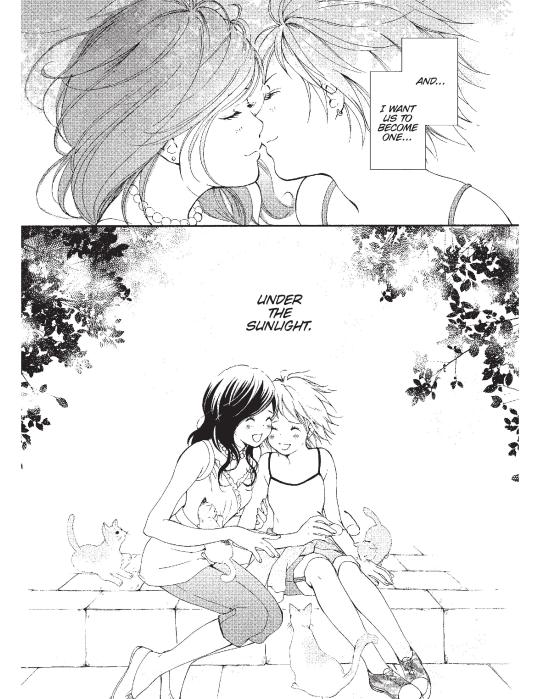
Grandiose exclamations about the greatness of Yuri aside, The Conditions of Paradise is simply a phenomenal manga. The anthology contains eight chapters, three of which are one-shots and the other five split between two couples. The one-shots feature a variety of plotlines, from a tragic love fantasy to a cute and trope-filled school romp. However, all the chapters focus heavily on the featured characters, exploring their motivations and feelings in deep, meaningful, and complex ways. Even the one-shots find ways to showcase the varied histories, passions, and personalities of the characters.
The first three stories in the manga, “The Conditions of Paradise,” “Beyond the Stars,” and “In Dappled Sunlight,” follow two young women. Itou Sarina is an office worker, and her old friend, Takami Sumi, is a traveling freelance writer who often comes to crash with her. The chapters tell of their relationship nonsequentially, showing the two women as friends, physical companions, and partners. Their relationship is full of care, love, and lust. This story is not a class S style emotional relationship, or a carnal “friends with benefits” deal, but a genuine queer partnership. Through the three chapters, readers see them express their interest and affection for each other, and their desire to grow closer and fall more in love. It is incredibly sweet yet thoroughly grounded.
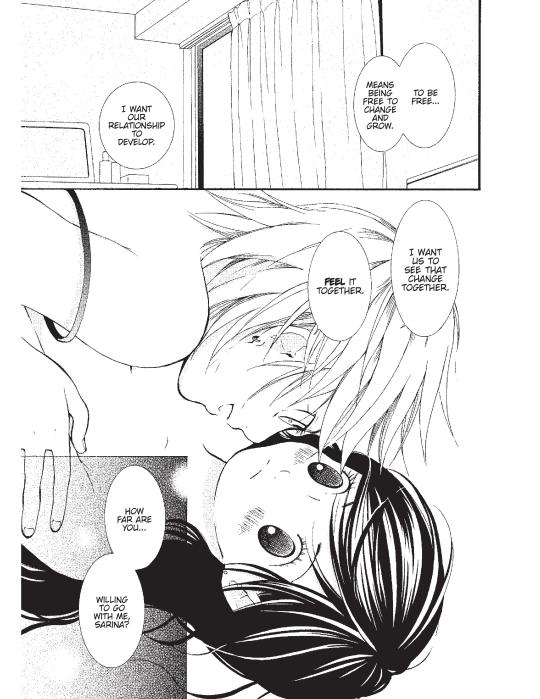
The following two chapters tell my personal favorite story. It follows the budding relationship of a slightly immature 30-year old art teacher, Kiryuu Keiko, and her 20-year old student, Aoyama Emi, who start a relationship after Emi confesses. Like Sumi and Sarina, the two have no shortage of love between them, with many panels dedicated to Keiko gushing over how amazing Emi is. However, I love this story because of the insecurities expressed by the characters. Keiko has anxiety about being intimate with her partner due to the age difference and concerns about her appearance. Even when she manages to overcome these trepidations, she is worried about how she will come across, questioning if she is being too aggressive or acting like a pervert. The resolutions to these conflicts all come from healthy communication, self-discovery, and working through problems logically and realistically.
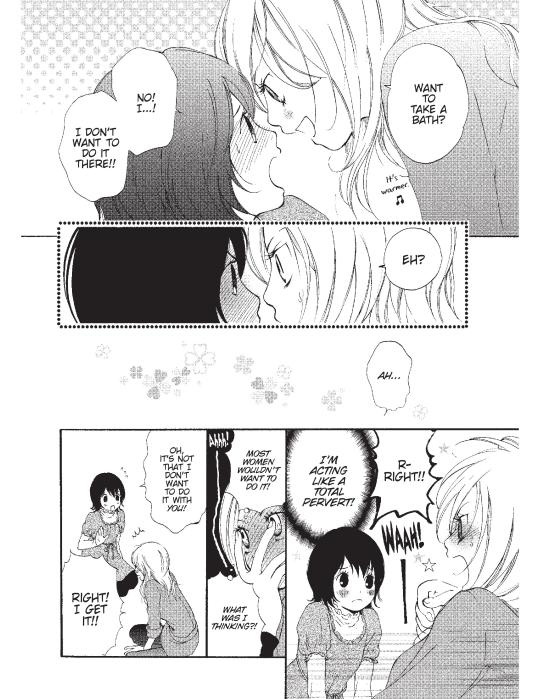
As previously stated, the three remaining chapters are one-shots. Of these, my personal favorite is “And We Strive for Love,” which tells a cute story about childhood friend turned couples dealing with childhood trauma and the mother of all height differences. While individually, none of these stories are fantastic, and in the case of “Peach Love,” somewhat dull, though otherwise benign, anthologies must be evaluated as a sum, a homosexual combination of all the queer parts within. Here, The Conditions of Paradise succeeds thanks to its strong characters and realistic romances.

Akiko Morishima’s excellent storytelling and characters are not the manga’s only strong points. Her fantastic artwork adorns every page. Although she is not one to do sweeping dramatic shots or emotional closeups, her stellar and realistic character designs shine, fitting each character’s personality perfectly. Expressions and reactions are often exaggerated for comedic effect without distracting the reader or overly distorting the figures. She also makes excellent use of blank space, focusing on the fantastic characters and their reactions to each other. A panel with two smiling characters so effortlessly communicates the sublime love between the women.
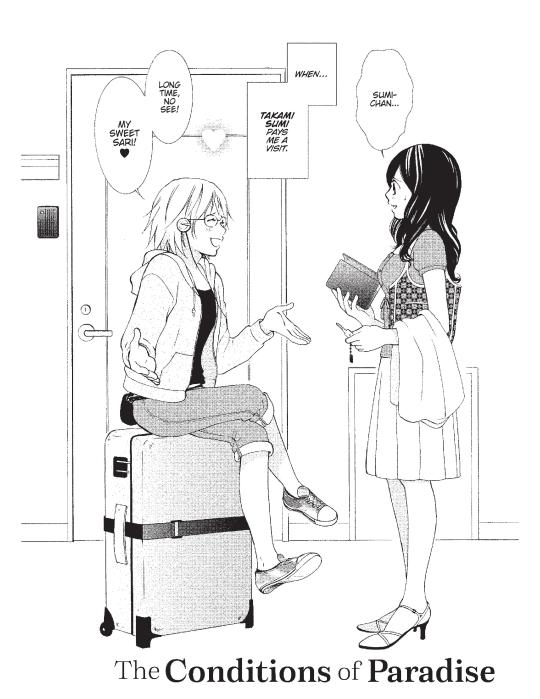
The mature themes of the manga are matched by artwork featuring some salacious segments, including snapshots of sexual encounters. These are thankfully not overly explicit or exploitative, with obscured views such as those seen on the title page. And yet the… “action” is still apparent and erotic. My only complaint again comes from “Peach Love.” The younger characters in this story have an unnatural cherubic expression. The large eyes Morishima favors for all characters are combined with overly rounded faces and plump blushed cheeks. The effect, ironically, is that everyone in that chapter looks to have shoved a few peaches in their mouth and are holding them there like some sapphic chipmunk.
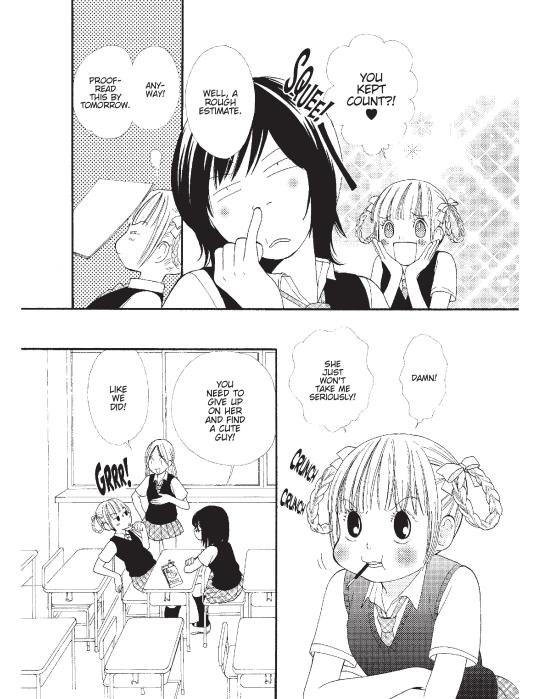
The Conditions of Paradise was one of the first, and maybe one of the greatest, showcases of real lesbian relationships. It is not the temporary schoolgirl loves of class s, a genre which was amid a massive resurgence when The Conditions of Paradise was published. Nor is the manga a pornographic exploitation of women made for the gaze of more sexually charged readers. While it contains depictions of female sex and sexuality, these are honest portrayals and compliment the grounded and thoughtful love stories. It is a masterpiece, a revelation, and one of the most important Yuri works ever created. The Conditions of Paradise’s more distinctive aspects and its value within the genre vastly eclipse any small faults with the story or artwork, resulting in a true classic of the genre.
I am so amazed and humbled to have read this book and to see its English release. Thank you so much to Seven Seas for licensing it and to Elina Ishikawa-Curran for a fantastic translation and Asha Bardon for an equally magnificent adaptation. They, and everyone else who worked on this project, have brought this tremendous offering to a new audience, and I could not be more grateful. The only thing left to do is award this masterpiece the perfect score it deserves.
Ratings: Story – 9 Characters – 10 Art – 7 LGBTQ – 9 Sexual Content – 5 Final – 10
Review copy provided by Seven Seas Entertainment
Purchase The Conditions of Paradise digitally and in print here: https://amzn.to/33GBkmB
Support Yuri manga, anime, and game news, reviews, and more on the YuriMother Patreon and on Twitter @holyyurimother
#lgbt#lgbtq#lgbtq+#queer#yuri#the conditions of paradise#manga#reviews#review#lesbian#lesbians#girls love#wlw#anime#history#classic
535 notes
·
View notes
Text
Top 5 Dislikes of Red vs Blue: Season 1
(Top 5 Likes)
So back a few months ago, in the lead up to RWBY Volume 7, I did a Top Likes/Dislikes list for all six volumes. I also did this for RvB Seasons 16 and 17, so… why not do it for the other fifteen? Especially with RvB18 on the way? Not only gives me an excuse to rewatch everything, but I get to have some fun~ So I will be covering RvB seasons 1-13 and 15. S14’s is gonna be a little bit different. But anyways, we’re gonna begin with the one that started it all, Season One~
Honestly though, critiquing Season One is hard. Mainly because this was a season made when RT was just a back bedroom with mainly Burnie and Geoff doing the machinima. We’re a long way away from RWBY-level quality. In the Blood Gulch Era, it was just a bunch of friends making dumb stuff. Quality dumb stuff, but dumb nonetheless. So the five Dislikes are honestly minor and I don’t even really consider them bad. If anything, they show how far the show has come. So take the Dislikes list with a grain of salt, ut I needed to do it for the necessity of the list. So then, let’s get started~
#5. Not Fully Fleshed Out Characters
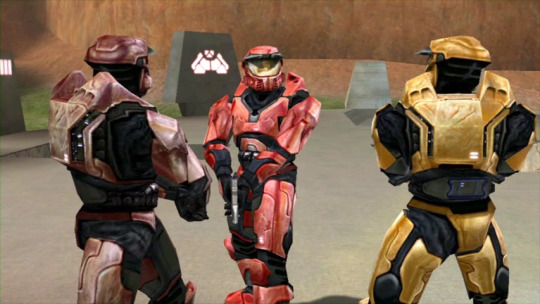
This is on the bottom because it’s really not that big a deal. The characters are kinda just somewhat exaggerated versions of the people that Burnie cast. They certianly have character, but aside from really Matt with Sarge, it’s just the cast playing exaggerated versions of themselves. It does kinda stand out because here, the characters don’t really have any defining personality traits or roles. We know a few things like Simmons being a kissass to Sarge, Grif is more out of shape, Caboose is a little dim-witted compared to the other Blues, etc. But when you look at all the future seasons, the lack of fleshing out is very noticeable. Especially for characters who are nothing like they were here, like Donut. I mean I don’t think he spouted even one innuendo here, it’s weeeeird.
Like I said though, this isn’t that big of a deal. The characters still have character and are still funny, it’s just clear that they hadn’t been fully developed. It’s a first season of what was originally meant to be a comedic miniseries and is very forgivable in that regard. It’s honestly fun to rewatch this season and then say Chorus and see how far the characterizations have come. Still, it is a tad noticeable and I needed five picks, so I’m gonna put it here. But again, it’s honestly fine. As is our Number FOur pick…
#4. The Voice Acting
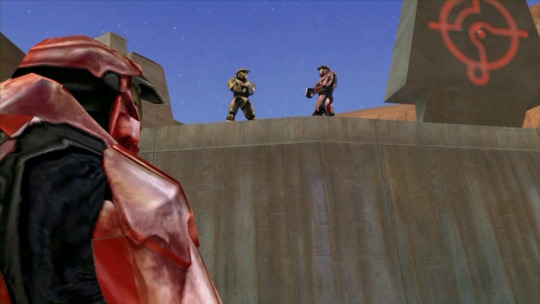
These guys, aside from like… two or three of them, were not actors. They hadn’t done a bunch of material like they have now either, so this is again very forgivable. But it does make the voice acting lover in me kinda cringe when I hear it. You can tell that they’re trying, but as I said, this was still in the early days when no one really knew what they were doing. The one who did the best were either already actors (Joel, Yomary) or had more of a character to play with (Burnie, Matt). Everyone else, as I said, was pretty much given an exaggerated version of themselves and I think it kinda shows in the voice acting. They were all okay, but compared to their later performances and when they are given more characterization, this was not their best work.
But again, this is not that big of a deal. This was the early days and as I said, you can tell that they were trying. I think ti honestly adds tot he charm of early RvB. A bunch of friends making dumb stuff with a video game. I mean Gus outright recording his lines over the phone while living in Puerto Rico, he and the others were clearly dedicated to this thing. It’s not the stuff of legends, but given the tone of Blood Gulch, it works. It’s a dislike because like I said, it annoys my voice acting loving self and it’s weaker to their later performances. But still, it’s very enjoyable… even if some of the voices some chose are kinda jarring. Speaking of…
#3. Sarge’s Voice/Not Fully Fleshed Out Character
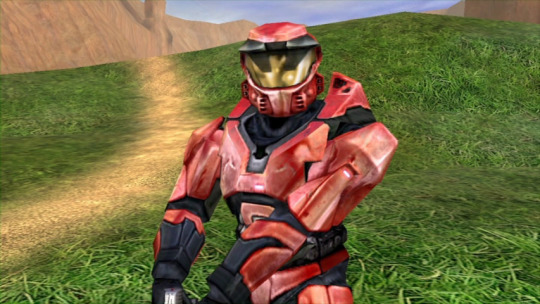
This one is super nitpicky, but it bothers me! We all know Sage and his overly exaggerated Southern accent, right? Well… in this one, he is much, much more subdued. Like I said, the characters weren’t fully fleshed out and so Sarge isn’t quite the same as we know him now. The voice reflects this. Here, Matt plays him like a stereotypical Nasty Drill Sargeant. IDK why, but the voice just… bugs me. I guess it’s just because I’m so used tot he current one, but it jarred me so much I had to check if Matt had been the one doing the voice in Season One. Sure enough…
Yeah, this one is very nitpicky and again reflects how I don’t feel the characters were very well fleshed out. I mean even comedic wise, Sarge didn’t really stand out and was really just there to give Grif a hard time. Even his hatred of Blue isn’t really there. Fortunately, this would be fixed in Season 2. Every time I look back at this though, it just takes me out for a minute cause ‘OMG this is not the Sarge I’m used too!’. So a nitpick, but a dislike nonetheless. But hey the fact that this is a minor issue speaks of how much I enjoy this season, haha!
#2. The Afterlife Scene
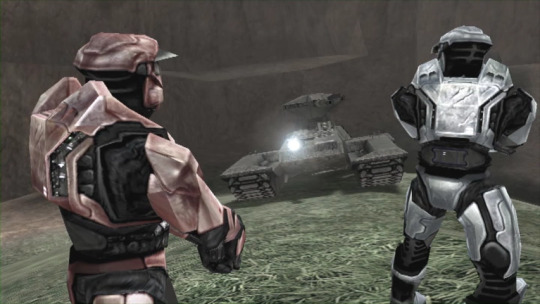
OH GOD THIS SCENE! IT CONFUSED ME ALMOST AS MUCH AS THE S3 TIME TRAVEL SCENES DID! ALMOST!
So… Blood Gulch is very weird. I mean it had Ghost Church, is this a surprise? But that wasn’t even the weirdest part of this season or even the entirety of the Blood Gulch Chronicles. No, that honor goes to this scene where, after Caboose shot Sarge when Church was possessing him, Sarge found himself in the afterlife. Church and Shelia are also there. Now, fortunately, Sarge comes back via Grif using CPR… on a bullet wound… yeah… but God this scene was the first time the show made me go ‘WTF am I even watching?!’ especially since unlike Chruch’s ghost thing, it never comes up again. Church having been an AI the whole time didn’t help.
Now I know it kinda got explained later as part of Recovery Mode, but it still leaves a lot of questions. Why was Church there? He got kicked out of Sarge’s body when he got shot. Maybe he went back in hopes of making it work? IDK. But maybe we can just say that since Church was possessing Sarge, he left some kind of trace and the Recovery Mode picked up on it. Cool… then why was Shelia there? Sarge wasn’t even at the canyon when Shelia was unleashed. Did Recovery Mode pick up on that from Church too since it was so recent? I guess that makes sense? And yeah I know that when they wrote this Church wasn’t intended to be an AI so maybe it really was the afterlife, but that’s no longer a possibility, so… AAAAHHHH!!!
Yeah… this is why I don’t try to think through Blood Gulch stuff too much. Doing so does nothing except make my brain hurt when I try to go over how it makes sense in canon. Don’t get me wrong, the scene was funny especially with Grif and Simmons trying to revive Sarge. Kinda feel bad for Grif for getting scolded when he just saved Sarge’s life, but it’s Sarge. Of course, he would. I also like the more muted colors int he afterlife and the weird wavy effects with the scenes in the world of the living. It’s a funny scene, just one that hurts my head whenever I try to make sense of it. Stupid me and my stupid need for logic…
#1. The Audio
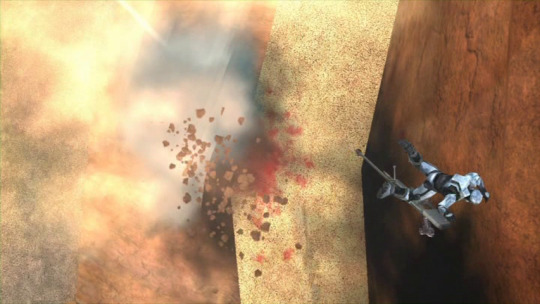
This was by far the biggest thing I noticed, including back when I started this back in 2017. The audio is… not good. I think this might help explain some of the amateur voice actings because half the time, the filter effect distracts you from the performance. Now I actually do like them using the filter since it makes sense that they’d use mics int heir helmets to talk, but I think that they tuned it up a little too much here. The whole reason they did this was to hide the fact that people like Gus, Jason, and all the guys in California had to record their lines over the phone. It’s one of the better decisions that they made, but like I said, in this season it is super distracting.
The only thing maybe worse is the mixing when it comes to explosions. There are a lot of explosion effects in this due to all the guns, grenades, and tanks. They are loud. Really loud. Like I remember watching the scene where Church dies. I was watching it on my laptop with headphones and I had the volume at a fairly modest time. The explosion noise made me jump. It can sometimes also overpower the voice acting like I think there were a few times I couldn’t fully make out what the Reds were saying when Shelia was firing at the end. Add that tot he voice filter and… yeah.
The audio wasn’t bad. Like I could tell what characters were saying. The effect was just distracting though and clearly they needed some work on audio mixing. Which they, fortunately, did by the next season. I think Burnie even mentioned how annoyed he got at the constant complaints about the filter int he Season 2 commentary, but hey he listened! Still, for Season One, it was by far the thing that annoyed me most and while I know it’s because they didn’t have quality equipment, it still distracts me when I rewatch. So it’s going to be my Top Dislike for Season One.
Final Thoughts
As I have tried to make clear, I don’t view any of these as major issues. Heck aside from Audio, IDK if I’d even say I disliked them. Thrown off by them sure, but not outright dislike. It honestly helped the show I think. It’s certainly mature and kinda crappy work, but it added to the charm and appeal to the show. It’s why they still use stuff like and photoshops, it’s endearing. Even with the improved production quality and while they have maintained a lot of what made RvB such a fun series, the original seasons still have this unique charm that despite how stupid it is, you just wanna tune into it over and over again. So these may be Dislikes, but they’re ones to be proud of. But hey I’ve still got plenty of Likes to talk about, so stay tuned for that~
5 notes
·
View notes
Text
i will never be accepting of the demonizing of akashi's mental illness in this fandom.
characters are understandably made into somewhat of a caricature once fandom gets ahold of them, because many people like exaggerating certain parts for comedic effect. and it is funny! it's alright to laugh about posts where akashi Is Absolute and Never Loses. or posts that joke about how he takes everything seriously, because he does and that’s not an exaggeration.
however, i've seen too much content in this fandom where people make bokushi (personality two) out to be some sort of villain while oreshi is a sweet angel who has been taken advantage of. and that is wrong.
pardon me while i go on a bit of a tangent. (a long, long tangent)
let’s start with his mental disorder. other issues such as anxiety and possible depression aside, akashi suffers from dissociative identity disorder (DID). now, i am not an expert in the medical field nor do i intend to be, but i’ve researched this disorder for the express purpose of trying to write akashi correctly. i’ve gathered and tried to analyze information as best as i can. i am a long ways from understanding it completely.
what i do know is that DID is often a result of childhood trauma. formerly known as multiple personality disorder, MPD, it is often seen as a very scary mental affliction because it is constantly, constantly, misrepresented for dramatic “shock” effect in manga and anime as well as american tv.
the thing that everyone has to understand about akashi’s DID, specifically, is that it did not split him into one “good” personality and one “evil” personality.
throughout his entire life, akashi has been put under intense pressure by his father, akashi masaomi, so that he can be raised as a successful heir to the akashi family. those who read the manga, especially, saw that akashi has been working ever since he learned how to read and write. his father immediately began to build him up into a prodigy and a genius.
every time akashi excelled, his father would pile more work upon him. as soon as he was done with one task, he was given two more.
the manga explicitly states that this is a workload that fully grown adults would complain and buckle under. it also states that his “only reprieve” from this workload was his kind and loving mother, shiori.
akashi’s mother passed away when he was in his fifth year of elementary school. that would make him roughly 9 years old. it was around this time that he began to break.
again, the manga explicitly states that masaomi continued to pressure seijuurou, and went on as though shiori had never existed. please refer to this post in regards to masaomi as a character, because @kurokolovesakashi put it better than i ever could (they also made a post about akashi’s DID but i couldn’t find it so)
at this point in akashi’s life, right after he’s lost the one person who actually seemed to love and care for him, is most likely where he began to dissociate
the actual definition for “dissociate” refers to disconnecting. in short,
one part of him was traumatized and found his life too unbearable to handle. this part of him is his “original” personality, who we regard as “oreshi”
there is a second part of akashi’s personality which split off from the first so that he could handle situations that reminded him of trauma or other stresses. this is the second personality. we know him as “bokushi”
in most situations where we see bokushi as the active personality, he really is characterized as violent and evil. he stabs kagami with the scissors, yes, and he threatens to gouge his own eyes out (side note: murasakibara once threatened to gouge someone else’s eyes out).
i believe that he is portrayed this way because fujimaki needed akashi to be a shounen antagonist. as in, dark and ominous. threatening. violent. someone who needed to be taken down, so that we would cheer for kuroko and kagami and seirin.
in truth, bokushi and oreshi have very minimal difference. no one outside of the generation of miracles noticed akashi’s change at all, indicating that they behave exactly the same.
do you know why?
because bokushi was created as a defense mechanism.
a defense mechanism is kind of useless if you know right away that something is different, right?
to people who are very close to akashi, though, the difference can be glaringly obvious. midorima, who was closest to akashi during middle school, noticed immediately. masaomi should have noticed, but he didn’t really give a rat’s ass about his son so long as he continued to succeed.
many of the distinctions that are made between bokushi and oreshi - the heterochromia, pronouns, etc etc - are made as a narrative choice by fujimaki for two reasons. one, he needed the crazy shounen villain. two, we wouldn’t be able to tell the difference if he hadn’t pointed it out to us.
other than the fact that bokushi is more aggressive in pursuing his interests, there is virtually no difference between he and oreshi. oreshi acknowledges in extra game that, as kuroko says, “there is no difference. akashi-kun is akashi-kun.” everything that bokushi did was something that oreshi was equally capable of, but he was too afraid to admit the error of his ways and behaved much in the way fandom did - he told himself that he and bokushi were two different people.
bokushi is not evil. oreshi is not perfect.
akashi is a broken teenage boy who’s been traumatized by his father’s treatment and is simply trying to find a way to function and continue to uphold the stress that is constantly piled on him.
sorry for the rant, i’m just tired of watching people write akashi off as some sort of monster.
146 notes
·
View notes
Note
Looking back, was Madoka Magica really that dark? Only three characters actually die, two of whom are later resurrected through the power of love. Blood and gore wise, most blood is offscreen, and that which is shown is fairly tame compared to other dark magical girl shows. Yet somehow, this show the show managed to hit me in the gut more than far more horrific and bloodier dark magical girl shows ever have. Why?
That doesn’t sound surprising at all, and it all comes down toexecution.
See,people often have this false idea when it comes to “mature” stories, inthat things like character deaths, blood and gore, and suffering are thebuilding blocks of maturity. But they’re not. They’re tools, and like all tools,they can be wielded correctly and incorrectly. Quite often, less is more, andtoo much grimdark results in an edgy, tryhard mess of a thing that isn’t maturein the slightest. This is one of the reasons why Blood-C got such a negativereaction, or why Elfen Lied is so divisive. I mean, don’t get me wrong, I loveme some Elfen Lied, but even I admit that it’s a schlocky white-hot mess. Itjust so happens to be my kindof schlocky, white-hot mess.
So yeah, I know this is weird coming from the apparent king ofTouhou Grimdark (cut me some slack though, I learn as I go), but gratuitousviolence does not, in of itself, equal maturity or anything of substance. Atbest you get the adolescent view of maturity, which is just so cynical andtiresome.
Madoka Magica, on the other hand, is a different sort of beastentirely. That show’s been out for years, but I am continuously impressed byjust how well-crafted it is, and how the creators used the tools at theirdisposal to get so much out of so little.
First of all, there’s the genre itself. Now, darkdeconstructions of Magical Girl shows are nothing new. Utena had already poppedthat cherry years ago, and you already mentioned how others had…less of animpact than PMMM did. But even so, the Magica Girl genre is one that’s almostuniversally associated with little girls. So, lots of bright colors, optimism,and cute, and the good guys and bad guys are easily distinguishable, and goodalways triumphs over evil. So even if new viewers know that something is up,their guard is still automatically going to be dropped, at least a little.
Second, we have the art style. Now, this is very interesting, inthat they went with a very Hidemari Sketch sort of style, where the girls allhave designs that are cute, appealing, and very distinctive, but never goingoverboard with the cuteness to the point where it becomes obnoxious. Even withthe fairly cartoony designs, their actual movement is pretty realistic, and isnever exaggerated for comedic effect or goes super-deformed and all that.Furthermore, rare for something of this nature, they are never objectifiedand/or used for fanservice in the slightest. A more realistic or a more adultstyle wouldn’t have been nearly as effective, nor would something sexier. It’sjust enough to make you like the girls and want the best for them, but notenough to get annoying or ruin the mood with unnecessary fanservice.
So basically, to get a little neckbeardy with it, the art styleis meant to make the viewers want to protect and comfort the girls, but notstrangle them for being way too moe, or fuck them for that matter.
…
Well, I mean, lots of people still do, but it’s the internet,so…
…
Moving on.
Anyway, continuing with theanimation, let’s talk about the witches. In sharp contrast to the somewhatcartoony designed but mostly realistically animated real world, the witchbarriers go for a surreal, dream-like feel, with the weird, jerky, low framerate movements of the witches and their familiars to the bizarre designs thatstick more-or-less to aesthetic themes but still have no explanation and anoverall look that, rather than being overly and obviously dark and evil, isinstead…wrong. Off. Alien. Discomforting rather than outright scary. Thewitches are meant to clash with the characters’ animation in a way that isdeliberately uncomfortable without spilling into cheesy. I mean, puffballs withbutterfly bodies and big handlebar mustaches? Spotted mice in nurse hats? Howis that scary? But just look at how they move, how they sound, and it becomesincredibly unnerving. Even before the big episode three twist, until which PMMMcould still pass for a more standard Magical Girl show, it still stood out withjust how bizarrely disturbing its monsters are. There is something genuinelyunsettling about them, a sense of dread that just permeates their every scene,even when our heroes are victorious.
And with that, I’ve exhaustedmost of the synonyms for “disturbing.” Let’s move on.
So, we’ve gone over how theart and animation is carefully crafted to evoke a specific reaction from theviewers, but what about the story itself? Well, like what was discussedearlier, part of what makes PMMM work so well is that despite its grandambitions and epic feels, the bulk of the show is…actually pretty small. Imean, save for the universe-changing repercussions of Madoka’s wish at the veryend, most of the focus is kept away from the world at large and remains on asmall group of characters and how being sucked into the contract system affectsthem. The story revolves around these five girls and is all about theirpersonal lives, and the whole Incubator thing is portrayed as alarger-than-they-can-imagine thing that’s been going on since the beginning oftime that they can’t do anything about, so why even bother trying? For Kyubey,it’s pretty much just business as usual, with the gang just being another setof marks in a long, long line of them, to be chewed up and spat out by the cogsof his machine.
And that takes us to what youmentioned earlier, about how PMMM has fewer character deaths, less violence,and nearly no gore in comparison to other shows, but somehow manages to leave abigger impact. And that comes down to one of the most important rules aboutstorytelling: it’s not what you’re about, it’s how you’re about it. Killing offcharacters doesn’t make a story mature, hurting your characters doesn’t makeyour story mature, or even using something as risky as rape doesn’t make yourstory mature; those are just the catalysts. Rather, maturity comes fromexploring how those things affect your characters, how it changes their livesand how they change and grow in response to them. Mami’s sudden and shockingdeath had profound effects on Madoka and Sayaka, and it’s by exploring thoseeffects that it feels like it has such a big impact, in that it shatteredMadoka’s perfect world and sent her into a bout of depression while motivatingSayaka into recklessness to compensate for her guilt in not being there to helpMami and overcompensate in trying to take her place. The reveal of the MagicalGirls as liches with their souls literally contained within their soul gems wasa big twist in of itself, but by taking the time to show how it set Sayaka intoher downward spiral into self-destruction coupled with having the oppositeeffect on Kyoko by jarring her out of her self-centered nihilism and motivatingher to start reaching out to Sayaka it really does feel like it has actualmeaning beyond shock value. And their deaths become even more tragic, asKyubey’s later monologue shows that they were doomed from the beginning, andnothing other than a damned miracle was going to save anyone. And being that hehad the monopoly on miracles in that universe, the audience is left bitingtheir nails and hanging on the edges of their seats through the climax, prayingthat an out would be found while fearing that there would be none to be found.Which just makes Madoka’s loophole of a wish all the more gratifying, whilestill being bittersweet. Because a happy ending just wasn’t possible, but shefound a way to prevent an all-out tragedy, a way to alleviate the bulk of thepain. And all it cost was her earthly existence.
Anyway, we’ve talked aboutthe visuals and story direction, so now let’s talk characterization. This is yetanother place where this show shines. Becauseeven though it only had a few episodes, the relatively small cast and focus ontheir personal problems allowed for a lot of character development. It helped that,save for Madoka’s, each of their wishes was something small and easilyunderstandable. Mami just wanted to live, Kyoko just wanted people to listen toher father, Sayaka just wanted her close friend and crush to get better whiletaking up Mami’s responsibilities, and Homura just wanted to save her dearfriend, who had been one of the few people to ever give her positive attention.Hell, even Madoka’s original wish was to save a cat. And like their designs,their personalities are all distinct, balanced between likeable strengths andtragic flaws: Mami is stalwart and nurturing, but also tripped up by hercrippling loneliness. Sayaka is determine and has a strong sense of justice,but also brash and prone to self-loathing. Madoka is kind-hearted andencouraging, but held back by her lack of self-esteem. As for Homura and Kyoko,they’re introduced us when they are at their worst, but do to cleverstorytelling and exposition, we then see the goodness in them and what theyused to be, and it becomes all the more easier to understand how they becamethe way they are. And again, despite its small number of episodes, the showreally takes the time to show how these personalities bounce off each other andconflict, while also showing how the consequences of their actions change them.I really like how they did it two: the show is essentially divided into fourmini-arcs of three episodes apiece, with the main focus on a different girl perarc, with Madoka being something of a passive POV protagonist throughout the wholeshow: first it’s Mami, then Sayaka, then Kyoko, and finally Homura. And as isexpected, each mini-arc ends in a tragedy, from Mami’s death to Sayaka’srealization about the truth of soul gems to Kyoko’s final stand to Homurafeeling as if she’s lost Madoka forever. But even with all that dark, it stillends on a note that is, while bittersweet, is still optimistic. Madoka is stillgone and Sayaka is still dead, but they seem to have come to terms with that. Also,Kyoko and Mami are alive and on good terms again, Homura has something new tofight for, and the universe is a little less cruel, showing that despiteeverything, it was all worth it in the end, and all of their struggles, pains,mistakes, and tears mattered.
I could go on and on and on,but let’s sum it up with a tl;dr: Puella Magi Madoka Magica may not have had nearly the amount of death and despair as other shows and very littlegore, but it had a far greater impact because it was carefully and brilliantlyconstructed from top to bottom to hit you right where it hurts, twist theknife, and still make you thankful for the ride. And I wouldn’t have it anyother way.
#pmmm#puella magi madoka magica#Madoka Kaname#sayaka miki#mami tomoe#kyoko sakura#homura akemi#gen urobuchi
460 notes
·
View notes
Text
Think Note Vol #59: Winter
Myojo 02.2018
(Translated from scans by MoMozzz32 on weibo. The photos are also from her account. Please let me know if there are any errors.)
I predict this winter will definitely not be a time I want to cover up*
* A reference to Momikeshite Fuyu, aka “Cover up winter~ There are no problems in our family~” or “The Kitazawas: We mind our own business” (GEMTV) or “Lots of Shit Happened in Rich People’s Families” (Taiwanese name 😂)
The atmosphere of the festive streets can make one’s heart dance and be lost in thoughts. His drama, “Momikeshite Fuyu ~ Wakaga no Mondai na Katta Koto Ni ~”*, is about to start. For Yamada, it is surely the beginning of an unforgettable winter.

----------
When people ask me “What is your favorite season of the year?”, up till now I have always said “spring & autumn”. However, when I see the city full of Christmas spirit, indeed I felt that winter is the best. I am not sure if it’s due to the splendid and romantic illumination or the TV stations enthusiastically playing Christmas songs, the end result is that I set up a Christmas tree at my place since the start of November (laughs). My tree is 50 cm tall and is pure white. Although I had bought ornaments for it, I wanted a silver theme, so I ordered a bunch of new ones from the Internet. The stuff got shipped this morning, so I look forward to hanging them on the tree♪.
When I was checking on the planters in the morning, I thought “It’s cold!”, so I think it’s a sign that winter is here. Even though it is my favourite season, at the same time, I feel a bit sad. Every Christmas, I end up meeting with a bunch of guys, listening to Chris Hart’s song and saying “It’s already the time of the year to be listening to this song~” (laughs); we said the same thing every year. We also watch the music videos of Christmas songs performed by various artists, and we declare that “Mariah Carey’s ‘All I Want for Christmas is You’ is the best after all.” Just how many times does the word “Christmas” appear in the lyrics?! Well, being able to say the same things with the same members is fun though.
On the work front, between shooting the winter drama and the concert, it is looking very busy. Every year, from the time the summer tours begin, followed by drama filming and movie premieres, music programs, “Johnny’s Countdown”.... and I think “the end of the year is here!” This winter, the TV drama “Momikeshite Fuyu ~ Wakaga no Mondai na Katta Koto Ni ~” (NTV) will start broadcasting in January, so it will be more busy than before. When it is that busy, I hope I don’t accidentally cover up my memory as well (laughs). Actually, the director-san for this drama is the same as the one for my first drama appearance, “Tantei Gakuen Q SP”. He is very blunt when he speaks but it is out of love… while he is a passionate person, for the 11 year-old me, I thought he was very scary (laughs). That’s why when I met him again this time, I told him about how I was so scared of him back then. Also, there is another director who had helped me since the drama “Scrap Teacher ~ Kyoshi Saisei”. So with all these familiar faces, I felt at home right from the costume fitting before crank-in; I think it is going to be a fun 3 months.
The character I am playing, Kitazawa Shusaku, is the second son (youngest brother) of three and he’s just some regular guy you can find anywhere. He is the only one not loved by the family, so from that point of view, it sounds similar to “Cain & Abel”, but it is nowhere nearly as serious (laughs). In this drama, when the “hopeless thing” of the episode happens each week, you will see everyone racing seriously towards erasing that problem, but the audience who watch the episode unfold will think they are being idiots and hilarious. It’s not that you’ll ready yourself and say “I need to see it!”, but if you happen to turn on the TV and start watching without thinking too hard, I hope we can make you laugh on a Saturday night.
“Watch ‘Momikeshite Fuyu ~ Wakaga no Mondai na Katta Koto Ni ~’♡ Bakyun* ♡” - Ryosuke
*sound effect similar to wham, bang, etc in cartoons.
Mini review of Momifuyu:
Freakishly long name aside, Momikeshite Fuyu (Momifuyu) is a family comedy that is at times ridiculous, at times heartwarming, and at times downright sad. Like seriously, I felt teary in a few scenes. He said above that it is like a funny Cain & Abel, but it is not exactly the case. Shusaku wasn’t unloved like Yu in Cain & Abel - it’s just that his family expressed love in a different sort of way. At least when I want to slap some of the characters, it is out of love!
It may take a few episodes to warm up to the characters and the style, but I ended up loving most of them by the end. It’s fun watching Yamada play the most un-Yamada character and a total trip if you happen to watch FMA, Namiya, then Momifuyu back-to-back. The ending was a tonal shift though, to put it gently, but nevertheless, I will like to see a sequel. 😅
The acting is more of a comedic style, so you may also need to get used to the somewhat exaggerated expressions and inner monologue, but you also never know when you’ll be hit with the feels. If you haven’t watched it, check it out on GEM TV Asia (if you have it & it’s still broadcasting) or the Eng sub from the HSJ fansub team:
Episode 1
Episode 2
Episode 3
Episode 4
Episode 5
Episode 6
Episode 7
Episode 8
Episode 9
Episode 10 FINAL

79 notes
·
View notes
Note
Orange, 5, and Poppy please!!!
Orange = Who is your favorite Noah/Akuma?
That’s kinda tough to decide. All of the Noah are fascinating and mysterious, and thus make it difficult to choose just one. I’m quite fond of Road, Wisely, and Lulubell. I am a bit obsessed with Neah. But the one I would have to say is my all time favorite would have to be Tyki Mikk. I know, it’s a bit cliched to choose Tyki, but still. He’s a complex character who has amazing characterization I must say. Not to mention that the way Hoshino draws him is breathtakingly beautiful. But the closer, what makes me like Tyki the best, is none of those things. No, I like him the best because he’s Portuguese. I’m a quarter Portuguese, and take heavily from that side of the family. To see a character who also has Portuguese blood makes me excited and proud.
5 = Which general is your favorite?
While I love Tiedoll to pieces, I’d have to say my favorite would be Klaud Nine. She is shown to be gentle and somewhat friendly, BUT THAT DOESN’T MEAN SHE WON’T KICK SERIOUS ASS. SHE IS THE YOUNGEST, AND ONLY FEMALE OF THE GENERALS WE STARTED WITH. HER INNOCENCE IS A GIANT FUCK YOU MONKEY. SHE’S ONE OF THE FEW WOMEN WHO RESIST CROSS’S CHARMS. SHE’S LIKE IF RIZA HAWKEYE AND OLIVIER ARMSTRONG HAD A CHILD AND RAISED IT ON SHEER BADASSERY. So, while yes, I adore Tiedoll, I LOVE KLAUD NINE.
Poppy = What do you think of Neah?
Despite how I might portray him in my incorrect quotes, I honestly don’t think Neah is anything close to that. I simply took a few facts about him, and exaggerated them for the sake of comedy. In all honesty, Neah registers as someone I would be wary to make an enemy of. He may switch between moods in the blink of an eye, to a comedic effect, but underneath that he has burning ambition, a loose? moral compass, and is willing to do pretty much anything to achieve his goal, whether it be slaughtering the rest of the Noah, or trying to activate Innocence he knows will act badly to him. In my mind, I constantly compare him to characters like Byakuran from Katekyo Hitman Reborn. Neah is a fascinating character to study, that’s for sure.
14 notes
·
View notes
Text
A Comparison of Show Boat (1936) and Show Boat (1951) [a critique]
Before you read the post, I’m warning you that I’m not a critique so this is how an amateur creates a movie critique. Still, I hope I helped. (there’s a TLDR version at the end)
A Comparison of Show Boat (1936) and Show Boat (1951)
Racial prejudice and other issues are prevalent in Show Boat from 1936 and Show Boat from 1951. Show Boat is a musical that shows people's diverse lives who worked or has/had affiliations with the Cotton Blossom, a showboat that roams around the Mississippi River. Everywhere they go, be it in Chicago, their life story is narrated through a musical. It was first performed in 1927 for Broadway and the entire musical was based on the novel with the same name, Show Boat, by Edna Ferber. If I were to rate these musical films in MTRCB guidelines or classification, this will be classified as "PG" wherein parental guidance is suggested since there might be some scenes unsuitable for all audiences. Show Boat is a drama, romance, and comedy rolled into one family film in terms of its genre.
The plot of the 1936 version of Show Boat is more accurate than the somewhat revised version from 1951. Scenes are lacking in the 1951 version compared to the 1936 version and there can be scenes lacking in the 1936 version because the 1951 version is revised and altered in some way. As expected, the 1951 version ended very differently than 1936 one, only that the musical numbers of every character are extended that makes this version of the film more entertaining, giving off comedic episodes. And since the musical is set in different timelines (the late 1880s, 1890s, 1900s, and 1920s), the 1951 version has failed to execute that in the film, and which the 1936 version has achieved. Plot-wise, the 1936 version is better. If musicality-wise, the 1951 version is better since the musical numbers are more festive.
In the 1936 version of Show Boat, I find that there are a few characters who have no personality or do not radiate liveliness when in fact, it should be observed because the film is comedy. Take Gaylord Ravenal’s (Allan Jones) character. He is indeed an exceptional performer, but in this version, he does not have a personality, very different from Magnolia Hawks (Irene Dunne) in this same version. But, no one would be suitable for Magnolia (Irene Dunne) other than him. Probably because he was not shown for several minutes and the storyline was focused on Magnolia (Irene Dunne) herself, Captain Andy Hawks (Charles Winninger), and others. It felt as if Gaylord (Allan Jones) is not given justice as a love interest to the daughter of the showboat captain. I commend Joe’s (Paul Robeson) character in this 1936 version of the musical, despite that he only has a few scenes, I see his personality, especially in his rendition of Ol’ Man River. Among my favorites are Julie La Verne (Helen Morgan), Captain Andy Hawks (Charles Winninger), and Queenie (Hattie McDaniel). Steve Baker (Donald Cook), Julie’s (Helen Morgan) spouse, is rather a concerned husband for his troubled wife, and how I liked Julie’s (Helen Morgan) singing along with Queenie (Hattie McDaniel) and Joe (Paul Robeson)—their voices are blending and transitioning nicely. Parthy (Helen Westley), a wife to Captain Andy Hawks (Charles Winninger), and a mother to Magnolia (Irene Dunne), is an almost-perfect character for her role. Her authoritarian aura is perfect and at the same time, she is a comedic relief in other scenes in the film but not as perfect as Captain Andy Hawks (Charles Winninger). I view him as a loving father, although he can be goofy at times but he is a real loving father. Meanwhile, Queenie’s (Hattie McDaniel) character is also a comedic relief, one of the characters bringing life to the film and an incredibly suitable match to Joe (Paul Robeson). Pete (Arthur Hohl) on the other hand, does not seem to be a boat engineer like what his character is, but he carried out his character very well as someone who bothers Julie (Helen Morgan), I thought he is Joe’s co-worker who is up to no good. The couple Frank Schultz (Sammy White) and Ellie Schultz (Queenie Smith) are quite effective comedians and performers on-stage and humble off-stage, most especially when they willingly help Magnolia (Irene Dunne) find work. As for the child Kim (Marilyn Knowlden), she did good, as well as the teenage Kim (Sunnie O’Dea) whose expressions are on-point in her short segment in the film.
In the 1951 version, I liked Gaylord Ravenal’s (Howard Keel) character. He has personality here (because he is shown countless times in the film) but unlike the 1936 Gaylord (Allan Jones) and Magnolia (Irene Dunne), this version of Gaylord Ravenal (Howard Keel) does not match with this version’s Magnolia Hawks (Kathryn Grayson). I cannot blame that Gaylord’s (Howard Keel) performance went ridiculously exaggerated that the original essence of Gaylord Ravenal is lost. The good thing is that Gaylord’s (Howard Keel) musical performance with Magnolia (Kathryn Grayson) is phenomenal, his baritone voice smoothly complements with Magnolia’s (Kathryn Grayson) soprano voice, they just do not have the chemistry as a couple in the film. Magnolia (Kathryn Grayson) is okay, she has the same omen with the 1936 version of Magnolia (Irene Dunne), both portraying a naïve character and in love. Now, the 1951 version of Captain Andy Hawks (Joe E. Brown) is one of the best portrayals I have ever encountered, the same with the 1936 version of Andy Hawks (Charles Winninger) but much better in goofiness. He could make you laugh, and in a matter of minutes, you are now sobbing. That is how convincing he is. This 1951 version of Andy Hawks (Joe E. Brown) is a ray of sunshine that does not make the entire 1951 film literally awful. As for Julie La Verne (Ava Gardner), she has the potential to make her character the Julie La Verne she is. Too bad that her character is changed throughout the film, and I am disappointed how her singing voice was dubbed by another. Her voice suited singing those parts. Furthermore, Julie’s (Ava Gardner) husband, Steve Baker (Robert Sterling), is all right. His character is perhaps adjusted, he became an abusive husband to Julie (Ava Gardner) while in the original plotline of Show Boat, he just left his wife (and she became an alcoholic). Parthy (Agnes Moorehead) is a strict mother and a comedian, but she does not give off a domineering vibe, much different than the 1936 version of Pathy (Helen Westley). I have nothing much to say about Pete (Lief Erickson), he is alike with Pete (Arthur Hohl) in the 1936 version of the film. However, I would regard the 1951 version of Pete as a boat engineer. Again, I applaud Joe’s (William Warfield) rendition of Ol’ Man River, the same with the 1936 Joe (Paul Robeson). His character is of greater importance in the film. Without the 1951 Captain Andy Hawks (Joe E. Brown) and Joe (William Warfield), the film would be incomplete. And as far as I can remember, I never saw Queenie in this film, even a glimpse of her. Unfortunately, I believe there is no cast assigned for Queenie in this 1951 version of Show Boat, I was expecting to see this version of her. They also omitted Rubber Face here. Also, I admire the fact that they have cast a real-life couple for the comedian couple Ellie Schultz (Marge Champion) and Frank Schultz (Gower Champion), no wonder they have the chemistry. This couple is funny, and I loved Ellie’s dancing. Finally, Kim Ravenal (Sheila Clark [uncredited]) did her role as Magnolia’s (Kathryn Grayson) daughter great, she seems to be enjoying portraying the character which makes her pleasing to watch.
The set design for the 1936 version of Show Boat is barely accurate for the period. Why is Julie holding Magnolia’s smiling closed-up portrait? It was the 1890s, they are supposed to have photographs taken by an ambrotype or a daguerreotype. The photograph quality is utterly impossible to create using a daguerreotype, let alone a handheld camera existing in the Victorian era. It would be acceptable if the year it is shown in the film is in the 1920s or the current year the film was released. For the 1951 version of Show Boat, I never noticed if the set design is suited for the time era the film is set in. But I am not sure about the elevator scene. I believe that is also in the Victorian era. Manual elevators in that era were popular and widespread, those manual elevators where you have to close yourself the elevator doors and such. And in that era wherein Magnolia and Gaylord are already together, the elevator with automatic doors or push-button doors was considered advanced or high-tech since it was recently introduced. Knowing that they settled in a famous Chicago quarter for the rich, I think that the elevator scene will be acceptable. The 1936 film is in black and white whereas the 1951 film is in Technicolor. Both version’s set designs are so-so. I find that the camera zoom-in for every character's dialogue is too much, few zoom-ins are enough. Visual-wise, the 1951 film is better because it is in Technicolor.
For the costumes, the 1936 version showed some scenes where the characters (including the extras) are wearing inaccurate costumes for a certain time era. Understandably, the costume designers in the 1930s are not that capable of creating accurate costumes because it takes a lot of effort and time researching and making every costume as authentic-looking as possible. In the 1951 version, the accuracy of the costumes has developed somehow. Colors are vibrant enough and the patterns unique to be recognized for the showboat actors because they are actors, and not vibrant and dull colors for the non-actors (and actors as well) with normal patterns, to be used for everyday life. If I am not mistaken, there are a few costumes with distinct designs and cuts that were trendy in the 1950s, and there are several in the 1936 version with the 1930s cuts or patterns for clothing.
To compare the sound quality of the 1951 version of Show Boat and the 1936 version, the older version is the least better. Recorders in the 1930s are not as advanced as the 1950s ones, 15 years later. The sound for the 1930s is a bit unstable, difficult to make sense of or grasp than the 1951 version (unless you are a native speaker or using closed captions or a person from that time era) despite having those both versions’ actors use a Transatlantic accent or also known as Mid-Atlantic accent.
Using the Theories of Performance to compare the 1936 version of Show Boat and the 1951 version of Show Boat, if I were to tell which one I liked the best, I would say that I liked both of them. Both of them should have been a very compelling story presenting timely issues such as racism or racial prejudice, mixed marriages regarded as illegal, forgiveness, and others but only the 1936 version has successfully integrated those into the film. Both versions have their special qualities, a handful of scenes are a tearjerker. Some scenes can be lacking in the 1951 version, but there are also scenes lacking in the 1936 one. The 1951 plot as the film ends differs from the 1936 plot that remained loyal to the storyline of Show Boat. Both films are funny and the dramatic scenes made me want to weep with the actors together. Great choice of casts to both versions, only that the two films are apparently rushed albeit their duration is almost 2 hours long and the storyline and some dialogues are revised for the 1951 version. I would not recommend the 1951 version of this film if you are a Broadway Show Boat fan because you might find it bland. Plot-wise, the 1936 Show Boat is highly recommended to watch first, and the 1951 Show Boat if you are seeking musicality-wise.
----------
TLDR
1951 version - more like a musical ; 1936 version - more like a film
1951 - Technicolor ; 1936 - black & white
1951 - storyline has changes ; 1936 - loyal to its plot
1951 - feels like a comedy ; 1936 - a little comedy with drama
1951 - audio quality better, actors can be easily heard / understood ; 1936 - audio quality is a bit “glitchy”
1951 - some original characters omitted ; 1936 - somehow kept the characters complete
1951 - lacking scenes but added additional scenes not in the original plot ; 1936 - also lacking scenes but many scenes are in the original plot
1951 - no teenage Kim ; 1936 - has teenage Kim
1951 - costumes, set, & props a little accurate ; 1936 - costumes, set, & props not that accurate
0 notes
Text
Episode 56: Love Letters
“Three’s a crowd.”
So, it turns out time passes in Beach City! Its residents aren’t in a Springfield Limbo where seasons change but ages stay the same, and this opens a whole new realm of possibilities to expand the ongoing narrative of Steven growing up by having him actually grow up. We really shouldn’t take this for granted, considering how easy it is for a cartoon to freeze characters (especially child characters) in time, and honestly my biggest initial takeaway from Love Letters is that it’s the first episode that deals with how the passage of time by itself, rather than a series of events like Steven’s adventures, affects the show and its characters. This is a show where Steven, Lars, and Sadie disappeared for a week and nobody seemed to notice, so yeah, it matters.
The reason time alone is a factor is because we focus on the all-but-forgotten Jamie the Mailman. After a cameo in Mirror Gem/Ocean Gem, Jamie disappears without a trace for thirty episodes. This isn’t remarkable for a side character, especially one whose only other appearance is the first scene of the third episode. Jamie may be sweet and funny in Cheeseburger Backpack, but on a show full of sweet and funny characters he was easily lost in the background.
Well, it turns out his absence for the latter half of Season 1 has an in-universe explanation, one that allows the show to hang a quick lampshade on the common trope of vanishing characters while reintroducing him to those of us that forgot he existed: Jamie was literally gone, looking for his big break in the bright lights and busy streets of the Sunflower State, the big KS itself, home of Dorothy Gale and the Rockin’ Chalkin’ Jayhawks, that’s right, Kansas.
I’m really glad he’s back! Jamie is similar to Ronaldo in his role as a background character and occasional lead whose cluelessness is played for laughs and occasional drama. Both are passionate about self-expression (Jamie through acting, Ronaldo through blogging and the occasional documentary) and show some skill at it, but think themselves masters. However, where Ronaldo fluctuates between funny and grating at the drop of a fedora, Jamie is a consistent force for entertainment; he never reaches the comedic highs of Ronaldo’s A-game, but we never suffer any lows.
The secret, I think, is that Jamie’s core kindness evokes empathy instead of annoyance when he goes off the rails. His silliness doesn’t hurt anyone, and in an episode where he could’ve turned bitter and nasty over romantic rejection, he handles it surprisingly well considering his maturity level in other regards. This reaction may be a thematic necessity to teach Steven and Connie and the audience a generic “honesty is good” lesson, but it sets the tone for Jamie’s fascinating ability to be self-important without being a jerk.
Jamie’s overacting always benefits from Eugene Cordero’s veteran comedy chops, but is amped up even further by Lamar Abrams and Hellen Jo’s delightful brand of hypersilliness (see: Steven and Garnet’s workout in Future Vision, Amethyst’s burial service in Watermelon Steven, all of Rising Tides, Crashing Skies). Jamie’s love letter is zany enough, but actually seeing him write it does wonders to enhance what could have been a simple letter-reading sequence. Even if Jamie didn’t literally write the letter this way, it’s a nice peek into his ridiculous self-image, complete with anime twinkles.
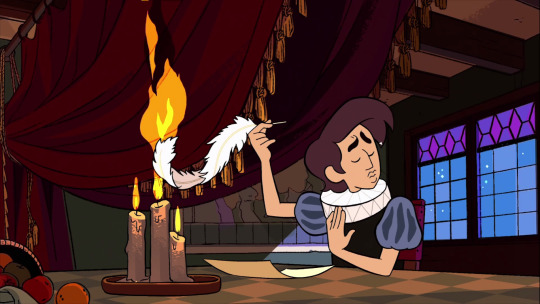
Steven and Connie are classic theatrical meddlers in a classic farce, where love letters gone awry and easily avoidable misunderstandings create melodramatic tension. It’s a nifty twist that they aren’t playing matchmakers despite their resemblance to middlemen like Don Pedro or Dolly Levi, but just want to spare Jamie’s feelings. And I love that Steven, a hero with a weakness for schmaltz, rejects the idea of Jamie and Garnet as a couple even before Garnet does, solidifying that neither the show nor our well-meaning but misguided kids are going in that direction.
(Love Letters also don’t drag out secret of who wrote “Garnet’s” response letter, which further subverts typical farce tropes but probably has more to do with the eleven minute runtime.)
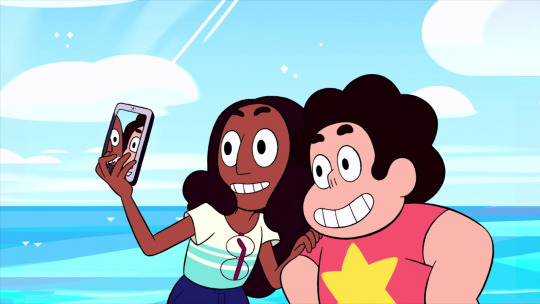
As Jamie says, Steven and Connie are super cute. It’s nice to have them as supporting characters (albeit the characters with the most screen time); we get snippets of them just hanging out in most of their episodes, but this time it doesn’t contrast with more serious drama like Connie’s replacement by a doppelganger or the possible end of their friendship. This is the first full episode of the two kids just being kids since Winter Forecast (oh look, another Jo/Abrams episode), and it’s soon to be followed by Connie’s temporary indoctrination; heavy episodes like Full Disclosure and Sworn to the Sword may be great, but a respite is appreciated.
Fortunately, a calmer (if wackier) tone doesn’t mean Love Letters lacks good character moments. Connie gets a quiet display of her growing emotional intelligence in the back-to-back scenes of Jamie’s admission of multiple rejections and the rewrite of Garnet’s letter. In the first scene, after hearing all about Jamie’s emotionally vulnerable state, she sees no issue with handing him another rejection and has to be stopped by Steven; whether or not ripping off the bandage is the right course of action, Connie’s reaction shows a distinct lack of tact. But in the second scene, she’s the head writer of the revamped letter (using the power of torrid soap opera know-how); even if she and Steven are way off-track in terms of how romance works here, she understands the problem and wants to help.
Little slip-ups and corrections like these do a great job of showing how far Connie has come from Bubble Buddies without losing the realistic awkwardness that makes her so endearing. Her disadvantage to Steven on the emotional intelligence front also continues to even out their relationship, as she schools him in book smarts throughout the series and will soon become a far more capable tactical fighter to his natural talent, a la Katara and Aang. Just because Steven isn’t an idiot and Connie isn’t emotionless doesn’t mean their differences have to go away, and Love Letters is a great example of her lower-key foil duty in action.
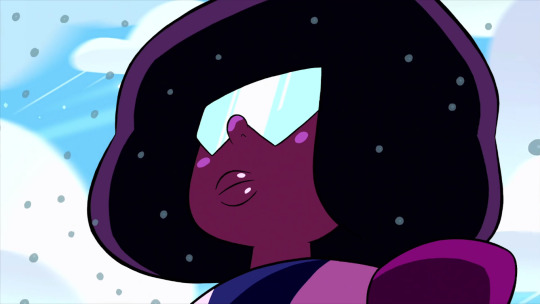
Garnet is mostly great as the oblivious, then apathetic subject of Jamie’s affection. Her sexualized emergence from the sea is played for laughs thanks to over-the-top visual effects and Estelle’s exaggerated sultriness. Visually, while her introduction may evoke classic Birth of Venus imagery, the more amusing sight gag can be found in the, erm, interesting positioning of Jamie’s mailsack malebag mailbag as he’s filled with sudden lust:
But back to Garnet. Her instant and insistent dismissal of Jamie may be cold, but it’s fair and faithful to her character: Garnet is locked down on the relationship front, and we’ve seen how little she cares about the feelings of human strangers from her interactions with Kofi (and her general demeanor). She benefits from having little to do with Steven and Connie’s scheming, which makes her another victim of poor communication who gets fed up with what she perceives to be a pushy admirer instead of doubling down on her bluntness to a point that might make her seem mean; it also reinforces how important is to take the feelings of both people involved in a crush into account.
Even so, my biggest/only issue with Love Letters is her final conversation with Jamie, where she dismisses his infatuation as a performance. I guess I get that she’s trying to let him down easier than before and is putting things in a way he understands, but there’s a much better way to differentiate between love and a crush than essentially saying his crush is delusional. As someone who’s had crushes and has been in love, sure, the latter is strong enough to make the former look tame in retrospect. But that doesn’t make infatuation an act, and for a show that’s all about feelings, Steven Universe could do way better at explaining Garnet’s point of view without being condescending about someone’s emotions (especially the emotions of a young audience).

That said, Jamie’s response is somewhat true: local theater, at least, is really solid advice.
Future Vision!
Beyond local theater being in the future, Love Letters gets a nice resolution in Jamie insisting that he’s moved on in I Am My Mom. And then we get to see that, uh, nope, he’s still holding the torch as of Reunited.
Our introduction to Barb is a long time coming, and the fact that she knows Greg telegraphs their low-key and largely off-screen friendship.
If every pork chop were perfect, we wouldn’t have inconsistencies…
Despite Garnet proclaiming that love at first sight doesn’t exist, The Answer more or less shows Ruby and Sapphire’s relationship to be just that. Maybe they spent more time on the surface getting to know each other than it seems, but as per its fairy tale nature, love springs up pretty much immediately. (And it’s great! But maybe don’t have that person be against the notion of instant love.)
We’re the one, we’re the ONE! TWO! THREE! FOUR!
I enjoy the goofiness here and the dedication to a farcical format for a theatrical character, and as I said, the acknowledgment that time is an actual factor for this show earns some points. But beyond not sticking the landing, and it’s honestly just a little too broad to be a favorite.
Top Fifteen
Steven and the Stevens
Mirror Gem
Lion 3: Straight to Video
Alone Together
The Return
Jailbreak
Rose’s Scabbard
Coach Steven
Giant Woman
Winter Forecast
On the Run
Warp Tour
Maximum Capacity
The Test
Ocean Gem
Love ‘em
Laser Light Cannon
Bubble Buddies
Tiger Millionaire
Lion 2: The Movie
Rose’s Room
An Indirect Kiss
Space Race
Garnet’s Universe
Future Vision
Marble Madness
Political Power
Full Disclosure
Joy Ride
Like ‘em
Gem Glow
Frybo
Arcade Mania
So Many Birthdays
Lars and the Cool Kids
Onion Trade
Steven the Sword Fighter
Beach Party
Monster Buddies
Keep Beach City Weird
Watermelon Steven
The Message
Open Book
Story for Steven
Shirt Club
Love Letters
Enh
Cheeseburger Backpack
Together Breakfast
Cat Fingers
Serious Steven
Steven’s Lion
Joking Victim
Secret Team
Say Uncle
No Thanks!
4. Horror Club 3. Fusion Cuisine 2. House Guest 1. Island Adventure
15 notes
·
View notes
Photo








Digital 3D: Flying Saucers Review
This week, we were able to get an initial introduction to Maya, a powerful animation, modelling, simulation, and rendering software. An application used widely in the visual entertainment industry, Maya is primarily used to build 3D computer generated assets for film, television, game development and architecture. As animators, we will primarily be using the software for modelling and animation purposes: designing and building our own characters, props, and sets in a 3D workspace and learning how to animate these.
The purpose of this first workshop was to be inducted to the absolute basics of the software, learning how to create predefined shapes (like a cube, cylinder or sphere) and move, duplicate and edit these basic shapes for animation. Using these basic tools and features of Maya, our task was to create and animate a scene featuring an alien abduction between a UFO and a farm animal. We were briefed on modelling a cow, but I wanted to take the time to challenge myself and work on something a little more visually pleasing: in this case, I chose a sheep.
For this task, however, I wanted to limit myself purely to making use of the predefined 3D shapes - sticking to the teachings of the workshop. Using a mixture of duplicated and edited cubes and spheres, I was able to build a 3D sheep that I think can be described as ‘visually pleasing’. My peers found the design to be appealing, and ‘cuddly’ through a cartoon-like use of spheres to replicate wool and highly exaggerated proportions. After building the UFO, which was essentially a series of cylinders and spheres, modelling the sheep was, comparatively, much easier.
My main challenge came from modelling the UFO, as creating equidistant orbs on the spaceship proved to be a technically difficult task. An entirely new software for me, Maya represents a new approach to the medium of animation that I haven’t really encountered before. Modelling is something I’d expected to find difficulty with, simply a result of the technical process that I haven’t quite grasped yet. With the guide of my tutor, however, I was able to create my UFO, and with this, I could then move onto the animation process.
The first animated test I was able to create has potential, but I ultimately ran out of time during the session. From what I can see, though, there is a visually appealing arc to the UFO’s lift off the ground, and the use of turquoise blue compliments the colour scheme well. Despite this, there is clear room for improvement - just with this initial test.
The main idea I want to convey with this sequence is that the sheep is too heavy for the UFO, which cannot fly in a regular pattern. In order to do this, I need to consider slowing the action down: have the sheep float around whilst in the tractor beam, which is slowly dragging the UFO down. Also, there is a jolting movement to the UFO’s rotation - something which can be smoothed out simply by extending the rotation sequence.
For the first introduction to Maya, admittedly I found it somewhat difficult to work as fast as the demonstration, but after asking the tutor for more help after the workshop, I was able to grasp a basic understanding of the program. I feel like I need to take the time to learn these new processes independently: this workshop provided a good introduction, but ultimately move too quickly for me to follow. 3D Digital animation is a medium I’ve never worked with before, and over these coming weeks, I want to challenge myself to get to grips with the medium. As a review of the software, however, I really enjoyed playing around with Maya. Digital 3D animation is one technique of the medium that I’ve never had the opportunity to explore before, and I found it to be an interesting and engaging challenge here. It’s a whole new approach to animation, and it will be difficult - however, I will be enduring this in order to develop my understanding of the program.
As a way to evidence this, I took it upon myself to create another attempt at the task: downloading the program to use at home and rebuilding the sequence from scratch, with a much more planned-out approach. Having settled on the idea of ‘the sheep is too heavy for the UFO, which then crashes’, I began sketching out quick, loose ideas for this in my sketchbook. This allows me to work from a very rough storyboard, and ultimately adds a sense of direction to my work.
Additionally to this, I explored Pixar’s approach to the task as a form of independent research: the CG short film Lifted presents a successful polished take on the alien abduction premise, adding a humorous touch which isn’t really felt with this type of narrative in traditional examples, which follow more of a sci-fi, horror approach to an alien abduction. Watching this example has clearly influenced my own approach to this task: following a comical direction that works to effectively subvert the audience’s expectations.
Having created the models already, my task was to create an engaging, humorous animation that conveys the weight of the sheep, show that the UFO is having trouble lifting it’s abductee away.
In this new iteration, I decided to create a flock of sheep, and have the sheep waddle up to the UFO and hit the ship: knocking it into action. Created a simple and minimal approach to an animated walk through keyframing the sheep’s position bobbing up and down, and playing with the rotation to create the illusion of a waddle. The purpose of this, however, was to embrace the limitations of a rig-less digital puppet and challenge myself to animate a walk using the simple animation tools we were taught in the original workshop. Unlike building the models, I found the actual animation process quite intuitive - in discussion peer, I likened it to a virtual stop motion process, only this method allows for both straight-ahead and calculated pose-to-pose animation. Using the keyframe technique to alter the sheep’s size, rotation, and shape, I feel like I have been able to create an interesting CG sequence here.
The sheep’s side-to-side waddle is appealing, I think. The use of anticipation and follow through add a sense of life to the movements, and having the sheep simply wiggle around on it’s back is able to engage the audience thanks to its ‘cuddly’ design and restricted nature of movement due to its exaggerated proportions. In comparison to my first attempt, this sequence is much more successful. Instead of a jolting liftoff, the UFO hovers above the ground with a sense of struggle through continuously moving up and down in no single direction smoothly: the purpose of this was to suggest that the alien driver doesn’t quite know how to fly this thing - adding a sense of humour to the piece. An added note is the continuously rotating UFO, a piece of secondary movement that further communicates that this vehicle isn’t from our planet.
A final addition to the sequence was the inclusion of a second, white tractor beam. This represents the alien driver’s last hope to abduct this weirdly-heavy sheep. When this also fails, the beams fly back up, and the UFO crash lands onto the sheep instead. The idea was to communicate a sense of struggle in the UFO, and that’s something that, through iterative development, I feel that I’ve been able to do here. As a way to consolidate these claims, I asked a peer for some critical feedback.
Firstly, the animation was a ‘successful sequence’, with strong use of anticipation before the UFO crash lands. They also noted the ‘appeal of the waddle’, and how this adds to the ‘cutesy’ design approach I’m trying to evoke. My comical approach is an ‘interesting take’ on the idea, and clearly holds some potential for further development.
However, it’s by no means a perfect sequence: in particular, it was suggested that I should explore how the light beams would also rotate and follow the same path as the UFO itself. This problem arises through a technical detail of not being able to parent the beams to the UFO and is something I would like to tackle again if I had the chance. Personally, I also feel that the light beam shoots down (and back up) far too quickly - something which could be improved rather simply by adding more keyframes in the movement.
A final suggestion from my peer feedback was something I hadn’t thought of: if I really want to develop upon this task, and present an outcome with polish, I should look at the possibility of rendering my sequence and explore the possibility of different camera angles for effect. The way the camera is positioned in the shot communicates a great amount of information about the subject of the frame: power dynamics, emotional themes amongst others - and so I should be taking advantage of the three-dimensional aspect of the project. This is something that I want to explore further: rendering a few seconds of animation from my sequence in various different positions to best tell this comedic story.
Overall, this represents a far more exciting and successful response to the task. Through iterative development and my own perseverance with Maya, I have been able to challenge myself to create an ‘engaging, successful’ CG animation that puts a new, comic spin on the farm animal abduction’ plot in this short sequence. Something I am going to put a focus on is iterative development on my practical exploration: this was the main point in the feedback of my previous unit, and it’s something I’m constantly considering moving forward. Here, iterations have allowed me to explore and further flesh out this simple CG sequence, and complete an animation (that, whilst simple in composition) demonstrates my leap in understanding of Maya as an animation and modelling program.
Next week, we will be exploring the modelling tools and interface of Maya: producing our own shapes and models instead of simply editing and altering existing ones.
0 notes
Note
Hello!! Sorry if you've already talked about this before, but do you have any thoughts on Tenko? o/ I love your blog!
I don’t think I’ve ever actually answered a question justabout Tenko herself! Thank you so much for asking, anon!
As with fanart, it’s hard to find content of Tenko just onher own. I love, absolutely love herwith Himiko as a ship, and I find her interactions with some of the othercharacters very fun or sweet, but I really wish there were more appreciation forher on her own. It’s true that she perhaps doesn’t get the most time to standalone even within canon, but still. I love Tenko, and I feel like withcharacters who make similar sacrifices like Kaede and Momota, it’s important toremember Tenko as being really great all around and appreciating her as acharacter in her own right.
Tenko is a character I know a lot of people were wary aboutprior to the game’s release, although without much to go on. Her design wascute but there wasn’t much that really stood out or indicated her talent, andher lines from the first few trailers and her likes/dislikes released with thedemo just indicated that she really didn’t like men.
What I was primarily concerned with prior to the game’slaunch was that she might get relegated to some kind of joke character—not inthe same way that I was worried about Ryouma getting treated as a jokecharacter because of his design, but mostly because I thought that if theytouched on her dislike of men at all, it would be in a way to try and make theplayers hate her, view her as an “unreasonable” or “stuck-up” character, andmostly all-around try to treat her as some kind of joke character who wouldneed to be “put in her place” or “taught” to open up to men after all.Thankfully, this is not what happened at all, and I’m so, so glad every day.
Tenko is one of the fairest, easiest-to-get-along-withmembers of the group. She treats pretty much everyone respectfully, and she’s ateam player through and through; her personal boundaries extend to not wantingmen to compliment her or touch her at all, and these things are regarded aspretty understandable by the rest of the cast. Even when her reactions to “DANshi”result in hilarious expressions and perhaps a few exaggerated outbursts playedfor comedic effect, she’s clearly well-liked by Kaede, by Saihara, and by prettymuch the whole group at large.
Even her honorifics reflect her sense of fair play. Unlikemany of the cast, who use “-kun” for boys and “-san” for girls as a staple,Tenko is one of the only ones besides perhaps Kirumi who uses “-san” for both.If she truly were trying to be mean or aggressive to boys only, then she’d useno honorifics at all, or some sort of rude and insulting nickname for each ofthem individually (the way Miu uses rude nicknames for the entire group at large,not just boys).
I’m glad for this, because it’s clear that by making Tenkowell-liked and a staple of moral and emotional support for the group, she wasn’tmeant to be a joke character of any sort. She’s highly encouraging to anyone atall who’s been upset or traumatized. While there’s no denying she’s much morecomfortable around the girls in the group, and that she particularly reallylooks up to and wants to be around Himiko, with less-aggressive orless-irritating boys in the group like Saihara, or Gonta, or Kiibo, she’s quitepolite, and very supportive to them.
And at the same time, while Tenko is undeniably a goodperson, I liked that she still had flaws of her own. Not huge, glaring flaws oranything, but just normal flaws that any ordinary person struggling to do theirbest might have. I still feel like ndrv3 did such a good job, better than anyDR installment in the past, with making the whole cast of characters feelparticularly more balanced and less one-sided. The characters who die early onin dr1 and sdr2 are certainly likable, but in my opinion, it was always alittle hard to get a feel for them. If you asked me to explain what flaws someof them had besides “being a little clumsy” or “too loud” prior to readingtheir FTEs or school mode, I probably wouldn’t have been able to tell you.
But with Tenko, a huge part of her character arc, and ofHimiko’s, was the fact that Tenko’s protective streak was also precisely whatwas pushing Himiko away. Since very early on, Tenko was thrilled with the prospectof Himiko’s talent, and clearly foundher very cute and funny to be around. Himiko was someone who inspired such aprotective urge in her that she wanted to be around her more and more, and sheclearly wanted to inspire her to get out and have fun and maybe be a littlemore open with her emotions.
But she came on so strongly that there’s no denying Himikowas a little uncomfortable at first. Someone as introverted as Himiko onlyfound Tenko’s attempts to draw her out of her shell tiring—and more thananything, Tenko’s insistence that she could protect her from anything andeverything, and her attempts to make sure Himiko was never in danger or doinganything too risky or outside her comfort zone kind of miffed her, becauseHimiko has a definite urge to prove herself and show off a bit preciselybecause of how small and seemingly helpless she is.
This kind of overprotective, somewhat coddling behavior is areally believable, understandable flaw, and something I think we’ve all been guiltyof at some point or other. I feel like there’s plenty of times for most peoplewhere we maybe assume too much about someone else’s abilities or don’t quitethink before trying to do something for them. And even if we don’t have any badintentions, it still hurts the other person, and I like that this kind ofbehavior was something that was addressed with Tenko.
And her good intentions were also addressed, and it wasclear that despite the fact that she sometimes came on a little too strongly orwas perhaps too smothering in her attempts to protect Himiko at first, shereally, genuinely cared, and she wanted to be Himiko’s friend in the truestsense of the word (and also her girlfriend). Tenko realized in the Chapter 2trial what a lot of characters in ndrv3 took much longer to realize: thatdoubting someone is perhaps sometimes necessary, but that trust is all aboutcoming to a conscious decision to believe in someone even after doubting them.
Tenko was killed off too early for my liking, and just aswith Kaede, I would have loved to see her take a more central role in the plotor receive more development, but I am at least glad that she was such a lastinginfluence and presence on Himiko. Tenko’s sincerity and affection for Himikowere so obvious to the entire group at large, many of them specifically commenton her feelings for Himiko even after she’s gone, and Himiko herself carriesTenko with her in her heart and keeps going for her sake specifically eventhrough the worst scenarios.
In addition to all these really fantastic reasons to likeTenko too, the cherry on top for me was realizing that the dislike of men and notwanting them complimenting or touching her was thankfully really not played assome comic relief thing. I’ve yet to read translations of any of Tenko’s FTEs,but I know that even in the Chapter 2 trial, Tenko specifically has a lineinvolving the fact that her father was drunk, and that he yelled a lot, which strikesme as a strong implication that hewas probably verbally abusive at the very least.
Given Tenko’s interest in neo-aikido and its measures ofself-defense, I was really glad to see a female character with this kind ofabuse implied her past whose aversion to men wasn’t treated as somethingneeding to be “fixed” or “gotten over,” and that everyone pretty muchunderstood that she’d be polite and nice as long as her boundaries wererespected.
Tenko is great, and I adore her, and as with most of thecast, I really, really wish she’d lived to the end. Couples rarely ever getoutright confirmation in the DR franchise, let alone happy endings, but I’dhave loved to have seen some AU with himitenko both making it until the end andbeing if not entirely happy then at least somewhat comforted by having eachother around.
#ndrv3#drv3#new danganronpa v3#tenko chabashira#chabashira tenko#ndrv3 spoilers //#my meta#okay to reblog#more appreciation for tenko more art for tenko more tenko in general please#anonymous
45 notes
·
View notes
Text
The dark, intrinsic humour of W.G.Sebald

Sizewell beach, with mysterious fridge that appeared one day - photo by author
When I first read W.G.Sebald, around 10 or 12 years ago, as a result of reading some review in either the London Review of Books, or was it the New York Review of Books, I forget which and certainly cannot recall which book was under discussion, I was like many before and since mesmerised by the dreamlike narrative flow, its meandering sentences that wind their way through sub-clauses and conjoin to form paragraphs that offer no natural pause for breath for many pages, its seamless shifts of direction, subject and focus, the aura of melancholy, the obsession with decay and destruction as the only historical constant, the omnipresent references to learning and facts that were often so obscure that verification would have been impossible or at least hard to achieve, even if there had been any point in seeking to ascertain to what extent the author – or was it the narrator, at whatever level, and in that near indistinguishable tone that left one uncertain unless the author constantly reminds us as often is the case who is indeed the narrator at a given point - was indeed imparting knowledge or learning grounded in what might be historically or factually verifiable material, and not least by the somewhat flat monotone of the English language of the translated text that was both natural yet incongruous, given the sad or so to speak dismal quality of so much of the content, and yet which seemed to match the gentle undulations of the ever-eroding Suffolk coastline that is the scene of his pilgrimage in the Rings of Saturn. Which is still my favourite.
What I had not registered, when I had read his main four works first time round, was any sense of the comic as part of, indeed intrinsic to, Sebald’s armoury. The books indeed gave the opposite impression – a hypnotic but constantly depressing perspective on the human condition and human history. But I now smile a lot as I read, in between the melancholy.
In recent months, and in part inspired by my desire to become more fluent (as reader, alas not yet as speaker) in the German language, and in part with an amateur’s interest in the techniques of translation, I have re-read both the Rings of Saturn and Austerlitz, this time in German as well as English, with the two language versions side by side. Or more precisely, around one page at a time in German followed by the same page in English, to see how far I had correctly divined the meaning. It was a very slow but often inspiring process. I saw - and also heard, as I read many passages half aloud to myself - how the German language version (which is the original) has a very different rhythm and tone from the English; it is far more expressive, alliterative and even onomatopoeic in the original, which is no criticism of his very fine English translators.
But above all, I had to read each word and clause closely, often several times, in order to understand the text, and thus gain a far stronger sense of what effect the author was aiming to achieve. And I have concluded – for all the terrible matters that Sebald recalls and recounts – that interwoven in the whole serious Sebaldian enterprise there is also a mischievous and dark sense of humour, almost always swimming beneath the surface and which from time to time emerges from the depths as evidently comic writing.

Sebald’s picture of Dunwich empty beach in Rings of Saturn
Or indeed, comic photography. For can we really believe, to take a random example, that Sebald’s photo (p.155 in the English version) of the North Sea at Dunwich, showing a dull unpeopled shingle beach devoid of interest or aesthetic quality, was chosen for any non-comic purpose? Dunwich, of course, was a godsend to Sebald’s general narrative of decay and transience; an example of a once-thriving port that has been destroyed and washed away by the forces of time, tide, storm and erosion. But the photo selected and inserted deliberately exaggerates and ironises the (in reality non-existent) contemporary boring-ness of the remaining hamlet.

Author’s photo of empty Sizewell beach, from which one wife has been ‘disappeared’
Now no one can accuse Sebald of not being mischievous (and misleading). On the very next page we find a picture of the “Eccles Church Tower” standing in the sand, just yards from the sea, which, he tells us, “still stood on Dunwich beach” until about 1890; moreover, “after Eccles Tower had also collapsed, the only Dunwich church that remained was the ruin of All Saints”.
I had never heard of Eccles Tower at Dunwich, but had assumed Sebald would not have made this up… but Sebald never claimed that he was writing pure documentary or accurate material. And he certainly wasn’t in accurate mode on this occasion. The Eccles Tower was so named because… it was never in Dunwich but in Eccles-by-the-Sea, 50 miles away on the north-east coast of Sebald’s own home county of Norfolk! The village and church of Eccles did however suffer a similar fate to Dunwich in that, over centuries, it was washed into the sea. (I learnt all this from a blog by Homo Ludens dated October 2007, though it is written about in more ‘literary’ reviews).

It is inconceivable that Sebald was confused or negligent about the Eccles Tower; since the facts are easily ascertainable by anyone truly interested, he can surely not have been hoping to deceive yet avoid discovery, nor does the insertion add any obvious narrative or other advantage (save maybe to underlines the unreliability of both the narrator and of memory in general). It seems to me that this is one of many examples of Sebald simply teasing his readers with games, amid his many horrific themes, setting them puzzles if they wish to delve further.
I am sadder (but wiser) to learn that there is no evidence that the train on the branch line from Halesworth to Walberswick was ever in the service of the Chinese Emperor in Beijing, as is proposed by Sebald.
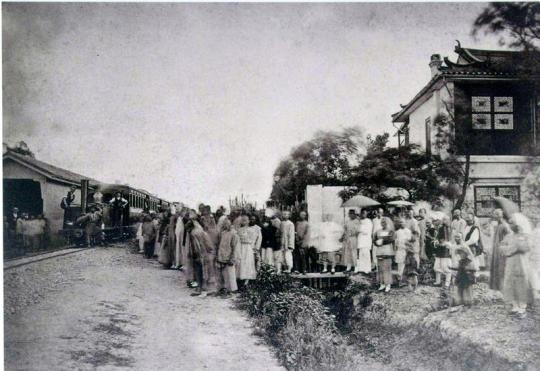
Photo https://en.wikipedia.org/wiki/History_of_rail_transport_in_China#/media/File:OpeningDay.jpg
It is a ‘truth’ that all readers surely yearn to believe, and the link is a literary necessity for Sebald to slide into the tale of imperialist interventions in China in the mid 19th century. Yet the fact that this tale of the Chinese train is pure invention is plain to see, once we realise that Sebald mixes playful post-truth with his more serious intent to recall past sufferings that humans have imposed on each other. He lures us into his false linkage as follows:
“According to local historians, the train that ran on [the branch line] had originally been built for the Emperor of China. Precisely which emperor had given this commission I have not succeeded in finding out, despite lengthy research; nor have I been able to discover why the order was never delivered or why this diminutive imperial train, which may have been intended to connect the Palace in Peking, then still surrounded by pinewoods, to one of the summer residences, ended up in service on a branch line of the Great Eastern Railway. The only thing the uncertain sources agree on is that the outlines of the imperial heraldic dragon, complete with a tail and somewhat clouded over by its own breath, could clearly be made out beneath the black paintwork of the carriages, which were used mainly by seaside holidaymakers and travelled at a maximum speed of sixteen miles per hour.”

http://thelostbyway.com/2013/09/w-g-sebalds-southwold.html
In retrospect, I cannot but admire and smile at the references to unnamed “local historians”, to the author’s “lengthy research” - which, alas!, does not help him succeed in finding out more - and to the unspecified “uncertain sources”.
Over the years, I have read many articles and exchanges about Sebald’s writing, but very few comment on the comedic dimension of his work, and those who do sometimes seem uncertain whether the effect is comic despite the author’s intention, or because he was, in the end, an implicitly witty writer, alongside his other qualities.
In her Introduction to “The Emergence of Memory: Conversations with W.G Sebald”, the American writer Lynne Sharon Schwartz emphasizes
“His dreamlike narratives, meandering yet meticulous, echo the lingering state of shock that is our legacy – not only from the wars of recent memory but from the centuries of colonialism that preceded them, indeed, history’s ‘long account of calamities’”.
But she adds,
“In the Rings of Saturn, to my mind Sebald’s best work, his imagination is given free rein and his digressive bent carried to its most extreme – almost comic – reaches. The swirling paths of thought cast a spell: if the reader is willing to submit, the author’s sensibility will carry him toward ever more tangled and distressing tales of decay, entropy, and destruction.” (My emphasis).
In a brief survey of the various authors’ contributions to her book, Schwartz notes that
“[Tim] Parks, incidentally, is the only writer to mention Sebald’s humor, which glimmers slyly through his pessimism and is often overlooked.”
And Parks himself refers to Sebald’s “accustomed blend of slyness and grim comedy” and describes how
“All too soon, however, and this is one of the most effective elements of comedy in Sebald’s work, the concrete will become elusive; the narrative momentum is dispersed in a delta as impenetrable as it is fertile.”
For me, and seemingly also for Parks, it is certain that Sebald knowingly wove comedy into his darker narrative meanders; and I am equally confident that many (though not necessarily all) of his factual errors (like the Eccles Tower) were likewise deliberately placed, either as a means of sliding the narrative apparently seamlessly in the direction he wanted next to explore, or simply as a game played with the reader.
Others are less sure whether the use of comedy and the falsified “facts” were deliberate. Michael Hutchins, in his contribution on Sebald in another collection of essays, “Authentisches Erzählen: Produktion, Narration, Rezeption”, claims that
“It often remains unclear whether Sebald’s faulty statements represent “learned jokes” or the work of a dyslexic scholar.”
And even the late Jenny Diski seemed uncertain about his comedic intent (or lack thereof). In an article in 2000 for the London Review of Books, she says:
“After a while this super-sensitised melancholy becomes comic. One’s patience is tried as it is with those tormented heroes of Dostoevsky, if you read them after adolescence. For God’s sake, Raskolnikov, get a hold on yourself, pull yourself together. Sebald’s narrator is for all the world a middle-aged existential wanderer, out of place, out of time, and wallowing in every miserable moment, sizing himself up against other grim, unhappy wanderers: Casanova in prison, Stendhal hopelessly besotted, Kafka tormented about his longings and terror of love in a clinic in Riva. There is comedy in the grim solemnity and it may well not be accidental, because, after all, if life is not appalling, it is absurd.” (My emphasis).
In his book “Understanding W.G.Sebald”, Mark Richard McCulloh sees the frequently satirical elements in Sebald’s writing, and clearly views this as intended by the author:
“The overriding mood many perceive in Sebald’s work is still the melancholy, the mournful, the autumnal. If one examines Sebald’s corpus as a whole, however, it becomes apparent that similar appellatives such as “melancholy” and “somber”…are simply too sweeping. There are satirical elements that emerge in his prose, products of his humor and astute powers of observation..”
Sebald has many critics who perceive only the dark side, and none of the humour which I consider to be the natural counterweight to his pessimism. Alas, Alan Bennett is one who only sees Sebald hoving to the darkly depressive side:
“Sebald seems to stage manage both the landscape and the weather to suit his (seldom cheerful) mood… ‘Never yet on my many visits […] have I found anyone about.’ The fact is, in Sebald nobody is ever about. This may be poetic but it seems to me a short-cut to significance.”
Whereas for me, the fact that for the narrator “nobody is ever about” is itself a reflection of the twinkle in Sebald’s authorial eye.
Michael Hofmann likewise fails to see much (well, in fact anything) positive in Sebald. In an article in Prospect magazine in September 2001, entitled “Sebald’s fog”, he not only dismissed his writing as a whole, but pointedly refers to his lack of humo(u)r:
“But what was even stranger was that Sebald operated without any of the rigmarole or pleasantness of the novel. The complete absence of humor, charm, grace, touch is startling – as startling as the fact that books written without them could enjoy any sort of success in England…”
And horror of horrors, in her 2003 New York Times review of “On the Natural History of Destruction”, the literary critic Daphne Merkin (1) sees any humour displayed by Sebald as simply being in poor cultural taste:
Needless to say, the colorless, nomadic universe he inhabits, where the pizzerias are dreary and the hotels unwelcoming, offers few flashes of humor except of the most heavy-handed, ironic variety (the eponymous Jacques Austerlitz recalls ordering an ice cream that turned out to be ''a plasterlike substance tasting of potato starch and notable chiefly for the fact that even after more than an hour it did not melt'').
I think this wilfully misses the broader point that in Sebald, the humour is in fact intrinsic to the very relentlessness of his dystopian narrative. Those constantly dreary pizzerias or hotels never fail to make me smile, knowing their type all too well…
It is true that on occasions – though they are not frequent – Sebald unleashes an overt, darkly ironic polemic, directed against some unsuspecting icon of modern life, great or small. In the Rings of Saturn, his description of the once (but no longer) prosperous and fashionable coastal resort of Lowestoft attracts his most biting prose.

Victoria Hotel Lowestoft with 1954 price list - including for servants. Photo http://www.oldlowestoft.co.uk/?post_WW2...:Hotel_Victoria_1954
The particular victim is the Victoria Hotel (in the English version, it is called The Albion; could it be the publishers feared a libel suit?) which seems in reality to have been a rather genteel establishment, but this is Sebald’s take on it in the mid 1990s:
I stood for a good time in the empty lobby and wandered through the public rooms, which were completely deserted even now at the height of the season – if one can speak of a season in Lowestoft – before I happened upon a startled young woman who, after hunting pointlessly through the register on the reception desk, handed me a huge room key attached to a wooden pear…. That evening I was the sole guest in the huge dining room, and it was the same startled person who took my order and shortly afterwards brought me a fish that had doubtless lain entombed in the deep-freeze for years. The breadcrumb armour-plating of the fish had been partly singed by the grill, and the prongs of my fork bent on it. Indeed it was so difficult to penetrate what eventually proved to be nothing but an empty shell that my plate was a hideous mess once the operation was over. The tartare sauce that I had had to squeeze out of a plastic sachet was turned grey by the sooty breadcrumbs, and the fish itself, or what feigned to be fish, lay a sorry wreck among the grass-green peas and the remains of soggy chips that gleamed with fat.
(The German language original is even better in its display of contempt for the offering – no attempt here at subtlety!). (see footnote 2)
Or take Sebald’s diatribe against the (then) new Bibliothèque Nationale in Paris… For me, this is again comedic, though not in any way that risks causing laughter. It is its sheer relentless grumpiness that – as it progresses - induces a smile in the reader, at least in me. The attributed narrator of this passage, Austerlitz, as cited by the principal narrator (who gives us no name but while doubtless resembling is not necessarily identical to Sebald) searching for traces of his father lost (and almost certainly murdered in a death camp) in the war, takes time out in the book to express at some length his utter loathing of the new library. One feels that Sebald is here hardly bothering to maintain the thin dividing line between himself and the narrator(s) – that he is simply using the opportunity to express his own contempt for the Mitterandian pharaonic building and its Kafkaesque minders; we sense that Sebald himself must have been displaced from the much-loved old Bibliothèque nationale in the rue de Richelieu (which by coincidence is the very same street in which the Paris office of the Conseil des Communes et des Régions de l’Europe (CCRE) was situated when I was its Secretary General…)
“I do not think, said Austerlitz, that many of the old readers go to the new library on the Quai François Mauriac. In order to reach the Grande Bibliothèque you have to travel through a desolate no-man’s-land in one of those robot-driven Métro trains steered by a ghostly voice, or alternatively you have to catch a bus in the Place Valhubert and then walk along the windswept river bank towards the hideous, outsize building, the monumental dimensions of which were evidently inspired by the late President’s wish to perpetuate his memory whilst, perhaps because it had served this purpose, it was so conceived that it is, as I realized on my first visit, said Austerlitz, both in its outer appearance and inner constitution unwelcoming if not inimical to human beings, and runs counter, on principle, one might say, to the requirements of any true reader.”

Photo via https://ilovearchitecture.wordpress.com/page/2/
And so on and on, not releasing its prey for pages, nor pausing for paragraph breaks:
“When I first stood on the promenade deck of the new Bibliothèque Nationale, said Austerlitz, it took me a little while to find the place where the visitor is carried down on a conveyor belt to what appears to be a basement storey but, in reality, is the ground floor. This downwards journey, when you have just laboriously ascended to the plateau, struck me as an absolute absurdity, something that must have been devised – I can think of no other explanation, said Austerlitz – on purpose to instil a sense of insecurity and humiliation in the poor readers, especially as it ends in front of a sliding door of makeshift appearance which had a chain across it on the day of my first visit, and where you have to let yourself be searched by semi-uniformed security men. The floor of the large hall which you then enter is laid with rust-red carpet, on which a few low seats are placed far apart… And of course, Austerlitz continued, you cannot leave the red Sinai hall for the inner citadel of the library without more ado; first you have to put your request at an information point staffed by half a dozen ladies, whereupon, if this request to any degree exceeds the very simplest contingency, you take a number, like a visitor to a tax office; you then have to wait, often for half an hour or more, until another member of staff calls you into a separate cubicle, as if you were on business of an extremely dubious nature, or at least had to be dealt with away from the public gaze, and here you must say again what it is you have come for and receive the relevant instructions.”
Even quoting these passages at some length fails to give their real feel, since it is precisely their being embedded in the constant unending flow of thoughts and prose that gives (for me) the clear feeling that Sebald is having a kind of malicious fun, a verbal revenge on those who created and now control the new fortress-library and jealously guarded and restricted access to its store of knowledge. And yet the humour is always embedded in the most serious; the overt purpose of Austerlitz’s research is his quest for a father lost to him, but who was no doubt destined – with assistance from the French authorities - for the Nazi death camp. Thus the comedy, which undoubtedly infuses his prose, is dark indeed.
For my final example of Sebald’s humour, I turn to Vertigo. Now, Vertigo – like the Rings of Saturn and Austerlitz - can hardly be deemed light relief; to cite Jenny Diski’s LRB review again
“Sebald’s vertigo is caused by the centrifugal force of uncertainty that pervades everything, including our consolations.”
Nothing evidently humorous there; yet as she later says, “After a while this super-sensitised melancholy becomes comic.” Her problem, as I have cited above, is that she is not clear whether the intent was humorous, or merely the effect. But, to take an example from Vertigo (p.103) cited by Tim Parks, can one really doubt that Sebald was quietly joking when he describes the narrator’s reaction to the sight of a beautiful nun and girl in a railway compartment?
“Opposite me sat a Franciscan nun of about thirty or thirty-five and a young girl with a colourful patchwork jacket over her shoulders….The nun was reading her breviary and the girl, no less immersed, was reading a photo story. Both were consummately beautiful, both very much present yet altogether elsewhere… I admired the profound seriousness with which each of them turned the pages. Now the Franciscan nun would turn a page over, now the girl in the colourful jacket, then the girl again and then the Franciscan nun once more. Thus the time passed without my ever being able to exchange a glance with either the one or the other. I therefore tried to practice a like modesty, and took out Der Beredte Italiener, [“the eloquent Italian”] a handbook published in 1878 in Berne, for all who wish to make speedy and assured progress in colloquial Latin.”
The Eloquent Italian! Yet Parks can only - rather comment,
“Only Sebald, one suspects, would study an out-of-date phrase book while missing the chance to speak to two attractive ladies.”
A page of the alleged phrase-book’s translation is offered us in a picture adjoining this text, with a few words or phrases underlined by someone… in English, these would be ‘all saints’, ‘Carnival’, ‘angel’, ‘sin’, ‘fear’, ‘truth’, ‘lie’ and ‘pain’…
The two females, as the train approaches Milan Central Station, insert bookmark or green ribbon into their respective tomes, and when it arrives “disappear”, leaving the narrator standing on the platform claiming a sense of having been abandoned but still able to pose ludicrously grandiose and meaningless questions, and to generalise from his own momentary attraction to the duo, to the generalised human yearning to copulate and populate:
“What connection could there be, I then wondered and now wonder again, between those two beautiful female readers and this immense railway terminus which, when it was built in 1932, outdid all other railway stations in Europe; and what relation was there between the so-called monuments of the past and the vague longing, propagated through our bodies, to people the dust-blown expanses and tidal plains of the future.”

Photo of Milano Central Station via https://commons.wikimedia.org/wiki/File:Skateboarding_at_Central_Station,_Milan.jpg
Here, Sebald has descended into surely conscious self-parody – the questions are meaningless, as he knows, and no answer is given. All the narrator does is stroll down the platform, and buy himself a map of the city. A city map which contained on its front, we are told, an image of a labyrinth, and on its back a claim to be “Una guida sicura per l’organizzazione del vostro lavoro” - “A secure guide for the organisation of your work”.
I cannot finish without citing one eminent source that supports my own view of Sebald:
“[His books] are notable for their curious and wide-ranging mixture of fact (or apparent fact), recollection and fiction, often punctuated by indistinct black-and-white photographs set in evocative counterpoint to the narrative rather than illustrating it directly. His novels are presented as observations and recollections made while travelling around Europe. They also have a dry and mischievous sense of humour.”
The eminent source is of course none other than Wikipedia – and against the last sentence we find the following addition: “citation needed”. Well, here I am.
Postscript
In reading quite a lot of articles about Sebald and his use (or non-use, or abuse) of humour I was happy – since my blog is named “Refractions”, to find two comments that refer to the Sebald as having a “refracted” view of the world:
“Sebald’s refracted and sometimes alienated views of both his native Germany and his adopted English homeland have had astonishing resonance in the German- and English-speaking worlds.”
Note on Amazon.co.uk page to W. G. Sebald - A Critical Companion (Literary Conjugations) Paperback – 1 Jul 2004
I was immediately hypnotised by the curious prose style, so flat and ostensibly inconsequential, which describes a kind of meditative interior monologue, not at all the world as it is seen and described by an ordinary person, but a view of the world seen through a glass darkly and refracted through the strange and sometimes uncomfortable imagination of a dyspeptic and exceptionally knowledgeable, middle-aged professor of German literature, whom one presumes has never been married and who decides to take a long and entirely purposeless walk round the shores of East Anglia meditating on aspects of its history and what he sees en route.
Charles Saumarez Smith Review of Austerlitz, The Observer 30 September 2001
Footnotes
(1) I know almost nothing about Ms Daphne Merkin but her review leaves me with a very, very dim view of her sense or sensibility - she says this in the same essay:
Who else but a gloomy, deskbound intellectual would warm to a narrator who chooses as his ''favorite haunt'' the Sailors' Reading Room in Southwold, which is ''almost always deserted but for one or two of the surviving fishermen and seafarers sitting in silence in the armchairs, whiling the hours away''?
Speaking for fellow deskbound gloomsters (not sure about the intellectual bit) I can assure Ms Merkin that the Southwold Sailors’ Reading Room is a wonderful, peaceful place overlooking the sea, in one of England’s favourite (for the middle classes, at least) coastal resorts.

Photo of the Sailors’ Reading Room via http://www.geograph.org.uk/photo/2607778
(2) The German passage, concerning the delicious fish and chips:
Dieselbe verschreckte Person ist es auch gewesen, die später in dem großen Speisesaal, in dem ich an jenem Abend als einziger Gast saß, meine Bestellung entgegennham und die mir bald darauf einen gewiß seit Jahren schon in der Kühltruhe vergrabenen Fisch brachte, an dessen paniertem, vom Grill stellenweise versengten Panzer ich dann die Zinken meiner Gabel verborg. Tatsächlich machte es mir solche Mühe, ins Innere des, wie es sich schließlich zeigte, aus nichts als seiner harten Umwandung bestehenden Gegenstands vorzudringen, daß mein Teller nach dieser Operation einen furchtbaren Anblick bot. Die Sauce Tartare, die ich aus einem Plastiktütchen hatte herausquetschen müssen, war von der rußigen Semmelbröseln gräulich verfärbt, und der Fisch selber, oder das, was ihn vorstellen sollte, lag zur Hälfte zerstört unter den grasgrünen englischen Erbsen und den Überresten der fettig glänzenden Chips.
1 note
·
View note
Text
Evaluation
The process of creating my final animatic and idea proposal has consisted of a portfolio of short stories and exercises, a series of refinements and even eliminations of ideas entirely. The idea behind my animatic was realised quite late on in to the project, as the previous idea I had was far too complex to fit into five minutes and therefore I had to create a much shorter story that could easy get its idea across in the given time and hopefully be understood by the audience.
The idea came from the flash cards exercise, in which we were given three different cards each with random objects on. From this we then had to create an idea from each object and then a story that contained all three. I felt like the zip idea was most successful as it took inspiration from real life from my own experience, so I could inject more personality into it and it also felt like the most inspired idea of the four. The story is aimed at a children’s audience and follows a day in the life of a little girl who gets stuck in her coat because she cannot unzip it. The original concept seemed basic in its approach, but upon getting feedback from my peers I then decided to add the independence element and idea of the little girl trying to be ‘grown-up’ and do things without her mother, but then realises that she is not as independent as she thinks as she then has to ask help from her peers and teacher and eventually her mum. We are shown in the animatic the little girl having her coat zipped up by her mother, and it is indicated that this happens every day and has done for years before she goes to school. However, on a day when her mother is speaking on the phone and seems to not have time to assist her, she decides to take matters into her own hands and attempts to zip up the coat herself which she does successfully. When she arrives at school as normal, she discovers that the zip is stuck and she cannot undo it, and neither can her teacher, so we see the little girl go from feeling very proud and independent to feeling quite panicked as she is essentially stuck in the coat. As she is stuck she has to go throughout her day wearing the coat, and we see her imagine a series of exaggerated scenarios at her desk, as the girl is supposed to quite young the situations are a bit ridiculous but they exist mostly for comedic effect and are told from a child’s perspective. The story concludes upon the little girl returning home, apparently very stressed out as the problem seems to have been exaggerated in her head, she finally asked her mother for help, who is also unable to unzip the coat. Finally, the mother simply pulls the coat over the little girl’s head, suggesting that the situation was easily solved in the end and that sometimes being independent is not always the right answer, she still relies on her mother but it is also a lesson for the little girl in that problems are not always as bad as they seem.
I think that my final idea was largely more successful than my previous ideas because it followed the three act structure by Syd Field more closely, as my initial idea didn’t actually have an ending and it was difficult to work out the ending. When coming up with the idea for the zip I had to consciously remind myself to split the story into the three sections, making sure each part worked. I feel like the ending is possibly quite weak however, as although the problem is resolved and the girl manages to escape from her coat by the help of her mother, the story wraps up quite quickly but arguably it is a simple solution to a simple story which was the idea. During the second act in the animatic, the little girl attempts to solve the issue by constantly forcing the zip herself in an attempt to undo it but continuously fails, suggesting that her initial attempts to resolve the issue have been unsuccessful, she is only abel to do this later on with the help of others. This is stated in the three act structure as protagonists often go through an initial but failed attempt at solving the issue, as they have yet to gain the skills or understanding of the situation, but ultimately they are a better person in the end. Initially when coming up with this idea, the little girl was going to be stuck in her coat and somehow find a way out of it, however it was only later that I added in the sentimental value of the relationship between the mother and daughter as well as the lesson learned of asking people for help. This was due to referencing the three act structure again, as upon reading through it I realised my protagonist was not really experiencing any sort of journey and the idea of being stuck in her coat was too simple on its own. I am unsure if the protagonist in the story has a higher awareness of who she is from going through that experience, but I think the animatic does suggest she took the monotonous routine of her mother zipping up her coat somewhat for granted, and perhaps this is where the moral lies.
I found the experience of creating the story and filling in the blanks quite stressful and tedious at times, as initially I could not think of a way the little girl would solve her problem. I also struggled with believability within the story, as I was unsure if an audience would think the idea too ridiculous, but ultimately the story is told from the eyes of a child and children do have much more heightened imaginations than adults and are sometimes unable to see reason. Turning the idea from notes into an animatic was also difficult as I was constantly trying to portray what was happening as clearly as possible, at the risk of over simplifying it.
Looking at the project as a whole, I am pleased with the way my animatic looks in areas, but I am less pleased with the idea behind the animatic as it is a genre I am not used to writing in so I am not confident in what works and what does not. The idea was perhaps not as interesting or entertaining when translated into the animatic, although it seemed to work in theory, I feel like maybe some shots are quite dull and repetitive for example when the protagonist walks to school. The scene in which the protagonist imagines different scenarios of her life wearing the coat also did not come across as successfully as I had hoped, as it was supposed to be a slideshow of different situations for comedic effect, but I think in reality it might be a bit slow to watch for the audience. There are also some parts of the animatic that are not completely clear, for example in the beginning when the little girl is having her coat zipped up by her mum each day, which is signified by the weather changing and the plant dying, is quite subtle and could easily be missed by the audience. This is then followed by her going to school and an almost identical scene of the little girl before school however this time her mother is on the phone and unable to assist her, so it may be unclear for the audience to what is actually happening as the scenes are so alike in appearance. I feel as though the story may suffer from ‘deus ex machina’ in which the problem is solved too quickly in the end, as the third act is quite abrupt if you look at the animatic as a whole. I was unsure how to avoid this when writing the story, as I was conscious of the story becoming too convoluted like my previous ideas and I really wanted to keep it as simple as possible so that it could be understood within the time constraints of the animatic.
Now that I have completed the work required for the module, I can say that there is definitely a lot of elements I would have approached differently if I could revisit it. For example, I would have given myself more time to refine my final idea, as although I feel it works better than my previous ideas, it is still quite rough and I am sure there are aspects of it that could be tweaked to make it even more effective. I think I realised this more when actually creating the artwork for the animatic, so perhaps this is a fault in my preparation and I should have planned out how I was going to approach it more effectively. I would have loved to have made it more appealing to the audience, perhaps injected more life into the characters and worked on the comedic effect of the film, even though there are elements of comedy within it, it is quite subtle and arguably to subtle for a children’s audience. There were some issues with the artwork being stretched when brought over to After Effects which meant the final animatic appeared slightly distorted, however I didn’t realise this until it was too late so in hindsight I should have checked this sooner. I think this module has taught me a lot about why an idea works and why it does not, before when planning out story ideas I never really considered a three act structure, and used to find organisation of ideas quite difficult, as my ideas always seemed really fragmented which I think you can see throughout my blog that my ideas go from being ridiculously convoluted to demonstrating at least some level of coherency. I will definitely take away these organisational skills, as well as the exercises that we undertook during the module, for example the flashcards exercise which is a really good device used to generate completely random ideas. I think I would definitely revisit this technique again as it really helps you to not revisit the same idea over and over again, and inspires you to experiment with genres and styles of writing you may have not tried before. I don’t think I would have thought to try a comedy style story directed for a younger audience before this module, and although there are areas I’m not entirely happy with I am somewhat content with the piece of work as a whole as it is an example of myself trying something that I am not totally confident with. There have definitely been aspects of this module that I have perhaps not approached in the best way, but I think the outcome has been successful in that I have undergone a research and elimination process to create an idea that does work in a very loose sense, and that I have responded to criticism and altered my ideas accordingly, so even if the finished product is not entirely polished and still a work in progress, the process of my idea development is evident, and my approach to idea generation has changed almost entirely.
0 notes